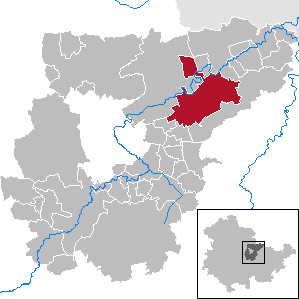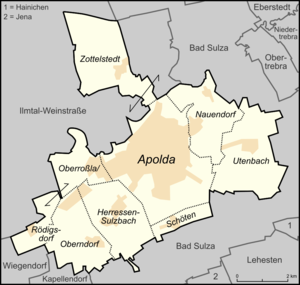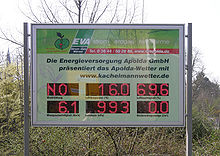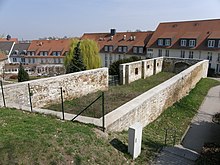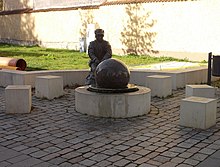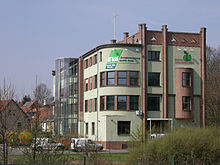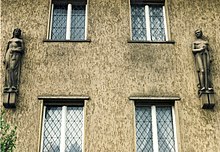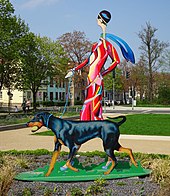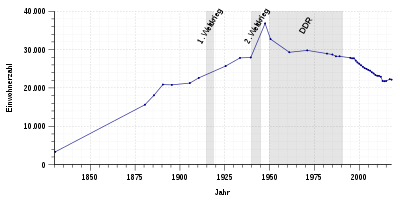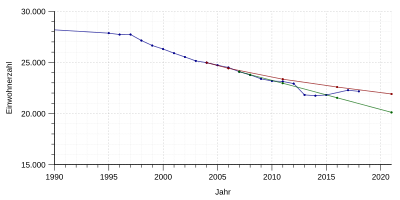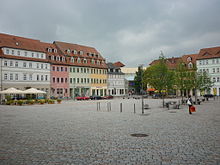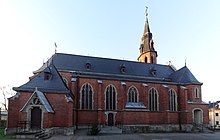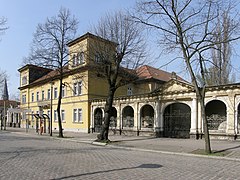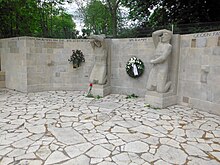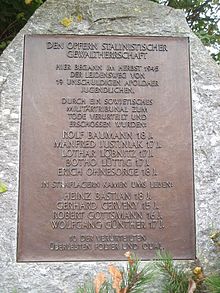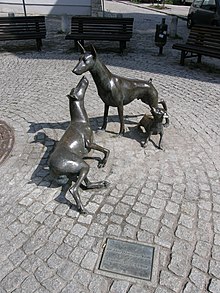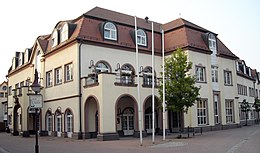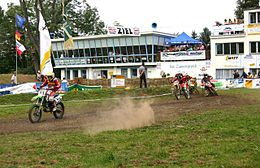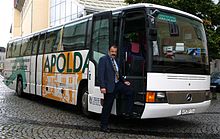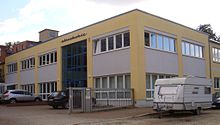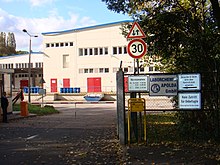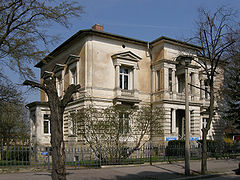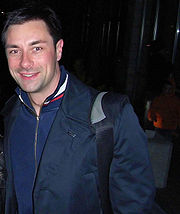Apolda
| coat of arms | Germany map | |
|---|---|---|

|
Coordinates: 51 ° 1 ' N , 11 ° 31' E |
|
| Basic data | ||
| State : | Thuringia | |
| County : | Weimar Country | |
| Height : | 205 m above sea level NHN | |
| Area : | 46.27 km 2 | |
| Residents: | 22,184 (Dec. 31, 2019) | |
| Population density : | 479 inhabitants per km 2 | |
| Postal code : | 99510 | |
| Primaries : | 03644, 036462, 036465 | |
| License plate : | AP, APD | |
| Community key : | 16 0 71 001 | |
| LOCODE : | DE APO | |
| City structure: | Core city and 8 districts | |
City administration address : |
Market 1 99510 Apolda |
|
| Website : | ||
| Mayor : | Rüdiger Eisenbrand (FWW) | |
| Location of the district town of Apolda in the Weimarer Land district | ||
Apolda [ aˈpɔldaː ] ( colloquially Abolle or Apolle ) is the district town of the Central Thuringian district of Weimarer Land in the city triangle with Weimar and Jena . The Ilm flows in the northwest of the urban area . In the regional planning of the Free State of Thuringia , the city occupies the rank of a middle center . Apolda was an independent city from 1922 to 1950 and has had the status of a district town since 1952.
Due to the more than 250-year-old tradition of bell-casting , the medium-sized town is still known nationwide as the "bell town". The manufacture of knitted and hosiery goods, which has also been in operation in Apolda for over 250 years, is also important. The up until then small agricultural town took off after the Thuringian Railway was built through Apolda in 1846 . The textile industry grew rapidly, and Apolda temporarily developed into the most important industrial city in Saxony-Weimar-Eisenach . From 1904 to 1927 the company A. Ruppe & Sohn, which was called Apollo-Werke AG from 1910 , built automobiles of the brands Apollo and Piccolo . The Dobermann breed of dogs was bred in Apolda and a memorial has been set here.
geography
Geographical location and geology
Apolda is located at around 205 meters above sea level in the eastern center of Thuringia on the regional border with East Thuringia and around ten kilometers south of the state border with Saxony-Anhalt . With an area of 46.17 square kilometers, Apolda is embedded in a flat, hilly cultural landscape on the edge of the Thuringian Basin and the Ilmaue with predominantly agricultural use and is located in the Weimar-Jena-Naumburg triangle. The city is located around 15 km northwest of Jena and northeast of Weimar, around 45 km east of Erfurt and 30 km southwest of Naumburg.
The city center, through which two streams flow, is located in a right side valley of the Ilm, a tributary of the Saale . At 162 meters above sea level, the lowest point in the valley is the bottom of the Krebsbach stream under the viaduct . The highest point is at the boundary of the district of Schöten with 273.6 meters above sea level.
The Schötener Bach rises in the district of Schöten and flows through the Schötener Promenade into the city center, where it flows into the Herressener Bach on the Heidenberg. The brook runs between the entrance to the promenade and the Heidenberg under a street that is therefore called Bachstraße .
The source of the Herressener Bach lies above the village of Frankendorf . The brook crosses it and passes through the towns of Oberndorf and Herressen-Sulzbach to the center of Apolda, where it joins the Schötener Bach, flows to Nauendorf and flows into the Ilm. Between Frankendorf and Sulzbach the Herressener Bach is called Sulzbach , between the confluence with the Schötener Bach and the confluence with the Ilm it is called the Krebsbach . Two mill ditches branched off from the Herressener Bach: one led past the town mill, the other ran to the Niedermühle. Both trenches later reunited with the stream.
East of Apolda rises with the shell limestone formation of the Jenaer Scholle, the northeastern part of the Ilm-Saale-Platte , while to the west the plains of the Thuringian Basin lie. The landscape design is the result of tectonic processes during the mountain formation and has a trench to basin-like structure due to a fault zone. The formation of the Apolda fault zone is probably due to faults in the lower mountains. The ground cover consists of black earth and loess-like alluvial clay of different colors. Lower Keuper mixed with gravel and sand occurs in the floodplains . The Pleistocene is only predominant in a strip from north to west . There you will find mostly older clay , whereas in the south of the city there is more recent clay. The east of Apolda is shaped by the border dolomite .
Urban structure and land use
The city of Apolda is divided into seven districts, whereby Oberroßla and Rödigsdorf are listed here together: (Status: districts 2011 - areas 2011)
| District | Residents | Area (km²) | Districts of the city of Apolda |
|---|---|---|---|
| Core city Apolda | 19,136 | 11.75 | |
| Herressen-Sulzbach | 594 | 5.41 | |
| Nauendorf | 146 | 4.92 | |
| Oberndorf | 307 | 4.93 | |
| Oberroßla / Rödigsdorf | 989 | 4.98 | |
| Pods | 250 | 1.27 | |
| Utenbach | 599 | 6.33 | |
| Zottelstedt | 368 | 6.56 | |
| total | 22,389 | 46.15 |
| Areas according to type of use | Area in km² |
|---|---|
| Building and open space | 5.87 |
| Operating area | 0.15 |
| Recreation area | 1.01 |
| traffic area | 2.91 |
| Agricultural area | 34.32 |
| Forest area | 0.77 |
| Water surface | 0.39 |
| Areas of other use | 0.74 |
| Floor area (total, rounded) | 46.17 |
Neighboring communities
Apolda is surrounded by four communities, all of which belong to the Weimarer Land district:
- Rural municipality of Bad Sulza (in the east and south),
- Kapellendorf and Wiegendorf (in the southwest; belong to the administrative community Mellingen ) as well
- the rural community of Ilmtal-Weinstrasse (in the west and north).
Climatic conditions
Apolda is located in the temperate climate zone . The mean annual rainfall of around 560 mm is less than the national average of around 800 mm. The wettest month is June with an average of 71.6 mm, the wettest month of February with an average of 31.5 mm. The wettest day in Apolda was June 27, 1953, when 100.1 mm of precipitation fell during a storm. The year with the most precipitation was 1966 with 764 mm, the one with the least in 1982 with 332 mm. The highest monthly precipitation height was reached in June 1953 with 236 mm, in October 1943, in November 1953 and in September 1959 the lowest values occurred with only 1 mm. In Apolda, precipitation falls on an average of 170 days a year. January has the most precipitation with 16 days and September the least with 12 days. On average, 36 days of snow or sleet are recorded in Apolda each year. On a long-term average, the first snow falls at the beginning of the third decade of November and the last in mid-April.
The sun shines 1400 to 1600 hours over the year. The annual average temperature is 8–9 ° C. The temperature curve corresponds roughly to the national German average. The months of July and August are the warmest with an average maximum temperature of 24 ° C, and December and January are the coldest with a maximum temperature of 3 ° C and a minimum temperature of −1 ° C. The wind mostly comes from the south-southwest to the west-southwest.
In 1265, 1613, 1728, 1734, 1739, 1909, 1953 and 1981 there were catastrophes in Apolda, some of which had devastating consequences. In 1265 many residents were killed by floods . On May 29, 1613, the Thuringian Flood washed away eight houses and drowned 24 animals. In 1830, three houses collapsed after a flood in Bachstrasse. In 1909 the market square was affected, it was turned into a lake. On June 26, 1953, another storm caused severe damage. The GDR Council of Ministers made 4.4 million marks available to repair the damage. The Herressener Bach was straightened above the city baths; Impact walls were erected in front of the brewery's premises on the Wehrweg and in the Schötener Promenade below the second pond. The streams were given a stone lining. The most recent flood on May 16, 1981, mainly affected the Faulborn road . Here some cellars were pumped out, the sidewalks repaired and retaining walls renewed.
In general, the climate is relatively warm and dry. Extreme weather such as storms, heavy hail or above-average snowfall are rare. In 2009 the minimum temperature was −20.9 ° C and the maximum temperature was 35.1 ° C. A year later, the minimum temperature was −16.7 ° C and the maximum temperature was 36.8 ° C. In 2008 Apolda was the hottest place in Thuringia with a maximum temperature of 35.6 ° C and was able to defend this "title" in the two following years.
|
Average temperature and precipitation values for Apolda
Source: Deutscher Wetterdienst - Measured values 1961–1990 Precipitation: Apolda and on weather.msn.com
|
|||||||||||||||||||||||||||||||||||||||||||||||||||||||||||||||||||||||||||
history
Early history and the Middle Ages

Already for the period from 4600 to 2000 BC First evidence of settlements in today's urban area of Apolda is available. Several settlements were established there in both the Bronze Age and the Iron Age . Since the 1st century BC Teutons from the Hermunduren tribe lived in the area. They had immigrated from the Elbe-Havel area. From the 8th / 9th In the 19th century, Slavic groups settled on the middle Saale and Ilm. The area of today's city of Apolda belonged to this territory. This country on the eastern border of the Franconian Empire was mostly populated by Thuringians , made up of Hermundurs and Turons .
The place is documented for the first time as Appolde 1119. A settlement with two churches, the Martinskirche and the Sankt-Johannis-Kapelle, was mentioned, which Count Wichmann from the noblemen of Querfurt gave to the Archbishop of Mainz Adalbert I of Saarbrücken . The name of the city can be understood as a Middle High German designation for an area in which there are many apples . Later the place was called Apollde, Apolle, Apolleda or Appulen. The Middle High German city name consisted of the syllables Appul = apple and - (e) de = area. Four years later, in 1123, a castle with a village under its protection was named in a document in which "Ditterich von Abbolde" was mentioned as a ministerial. The age of this castle is disputed. Sometimes the seat of the Counts of the Gau Husitin was assumed there, there is no evidence for this. The results of current archaeological excavations have not yet been published.
In the second half of the 12th century, the castle became the ancestral seat of a family of ministerials of the Archbishop of Mainz, in which the offices of Vice-Dominus of Erfurt and the Archbishop's cupbearer were hereditary. Around 1175 the family split into the two lines of Vitzthume (derived from Vicedominus ) and the Schenken von Apolda. Under their common rule, the settlement developed into a town in the second half of the 13th century, and both lines remained rulers until 1348. The Apolda taverns had their own mint in 1260. The coins were called Apoldsche Schenken . In 1289 the castle settlement Apolda received city rights as well as its own coat of arms and seal. Their residents were referred to as "city citizens" in a document. The city was later walled and had two gates.
In 1348 the Apolda taverns renounced their rights to the city in favor of the Vitzthume. Soon afterwards, at the end of the 14th century, the line of taverns in the male line died out. The Vitzthume let themselves be feoffed at the same time by the Wettins with Apolda , whereby the overlordship practically passed to the Wettins. As a result of the division of Leipzig , Apolda came to the Ernestine Saxony in 1485 . The Archdiocese of Mainz maintained its claims as overlordship for several centuries and only gave up in 1666.
At the end of the 13th century, a small town hall was built in the middle of today's market square . The oldest surviving municipal constitution was created in 1440; it is handed down in the so-called Red Book . It was not until the 15th century that the city's first council, consisting of two councilors, several councilors and quarter masters, was formed instead of the mayor . In 1524 the castle lost, among other things, the St. John's Chapel during a major renovation.
Reformation and Thirty Years War
In 1528 the visitors Melanchthon , Myconius and Schurff introduced and spread the Reformation in the city. As early as the 16th century, Apolda had grown far beyond the walled city area. A suburb had formed around the Martinskirche , which by 1530 was larger than the legal town. The residents of the suburbs were counted among the residents, but had fewer rights compared to the “urban residents” who lived within the city fortifications . They felt this especially on market days. They were only allowed to go shopping when it was reported to the town hall, that is, when a bundle of straw ("wipe") or later a flag had been removed. The area around Schulplatz, Goerdelerstraße, Bernhard-Prager-Gasse, Teichgasse and Lindenberg belonged to the suburb.
From an economic point of view, Apolda was an agricultural town located away from important trade routes such as the Hohe Straße , which ran to the north and had local significance as a market for the surrounding area. From 1558 to 1559, under Christof von Vitzthum, today's town hall was built on the east side of the market square. The name David the Strickermann appeared in the hereditary interest register in 1593 . It is said that he laid the foundation for the knitwear industry in Apolda by teaching the people of Apolda to knit stockings with five needles. A new fountain was erected in his honor and inaugurated on May 4, 2013 on the newly designed school square: In front of the knitting figure, a large ball rotates above a fountain base on high-rising water.
Previously assigned to the Duchy of Saxony-Weimar , Apolda was under both Weimar and the Duchy of Saxony-Altenburg since the Ernestine partition in 1603 . In 1634 it came completely to Altenburg, and from 1672 it belonged to the newly founded Duchy of Saxony-Jena , but after its early extinction in 1691 it became part of Saxony-Weimar again (from 1741 Saxony-Weimar-Eisenach ).
During the Thirty Years War in 1632, 1635, 1636 and 1639 war hordes and soldiers looted the city. After the Apolda line of Vitzthume died out in 1631, the Ernestines moved in as a settled fief and handed it over to the University of Jena as Dotalgut in 1633 . The university exercised the judicial rights in Apolda until 1837 and, after the extensive demolition of the castle, held the estate until it was transferred to the city in 1922. In 1674 the renaissance building of the town hall was redesigned in baroque style and a tower was added.
Economic development in the 18th and 19th centuries century
Soon after the introduction of the hosiery chair at the turn of the 17th and 18th centuries, a stocking factory was established in Apolda , which was to become decisive for the city's economic development. By the beginning of the 19th century it had developed into one of the most important economic companies in the Duchy of Saxony-Weimar. The number of knight's chairs rose rapidly from ten in 1700 to 780 in 1779, with a roughly constant number of around 3500 inhabitants. At the same time, the city was expanded to the north and east and the old city fortifications with the two towers were largely demolished shortly before and after 1800. At the end of the 18th century, however, there was a deep crisis that paralyzed urban development for a long time. The cause was the dependence on exports to the areas outside the duchy and the simultaneous mercantilist economic policy that inhibited imports and exports of goods.
In 1722 Johann Christoph Rose set up the first bell foundry to cast the bells for the planned new church. One of them, the so-called Wintzer Legacy Bell , is still rung in the Luther Church . The subsequent bell-founding families Ulrich and Schilling made Apolda known worldwide as the bell town. In 1878 Franz Schilling senior became the owner of the Carl Friedrich Ulrich bell foundry. This specialized in carillon from 1911 under the name Franz Schilling Söhne . She made chimes for churches in Asia, Africa, Europe and America. The trading house Christian Zimmermann & Sons was founded in 1789. This gradually began the upswing of the textile industry in the city, which only increased significantly in the middle of the 19th century. The establishment of the German Customs Association , the connection of the city to the railway network and the use of the steam engine had a major influence in 1833 .
The construction of the railway viaduct over the Krebsbach in 1845/46 formed the prerequisite for the connection of Apolda to the Thuringian Railway from Halle to Erfurt and had a very positive effect on the city's economic development. The railway line was initially planned at a greater distance from Apolda (via Niederroßla and Mattstedt) in order to avoid the expensive bridging of the Krebsbach valley. However, after the Apolda entrepreneurs had agreed to pay a fee on every hundredweight of freight for a limited period, the building company relented . She ordered the construction of the railway line via Oberroßla and Heusdorf and waived the levy. Instead, the government of Saxony-Weimar-Eisenach, which was involved in the company, proposed that the levy be raised for a charitable cause. Eventually the hospital, which opened in 1854, was financed with it.
On January 17, 1863, a city library was opened in Apolda on the basis of a donation of 225 volumes and 5000 thalers from the citizen Gottlob Müller, who died in 1860. In the same year the first Apolda dog market took place. Later, the Doberman Pinscher bred in Apolda was presented there.
At the end of the 19th century, the conversion of stocking production to the manufacture of fashionable knitted and hosiery goods was of great importance for the city's economic development. This was accompanied by further growth of the city and the construction of numerous public buildings, factory buildings and residential houses, both in perimeter block development in the style of historicism for the workers as well as villas and residential houses.
After the fall of the Socialist Law , with which the social demands of the rising working class had been suppressed for two decades, broad activities of the now admitted SPD and the unions developed in Apolda . The master weaver August Baudert , who founded the German Textile Workers' Association in 1891 and anchored it in the union, played a decisive role in this . In addition to his job, he worked for the workers' newspaper “Tribüne” and, as editor, designed its supplement “Free Press for Apolda and the Surrounding Area”. He founded the local SPD association in Apolda, under the umbrella of which numerous social and cultural activities were gathered, such as a workers' cycling club, the association of free singers, the free gymnasts, etc. Intensive public relations work made prominent speakers appear in Apolda such as August Bebel , Wilhelm Liebknecht and Karl Liebknecht . In 1893, Baudert opened a workers' bar on Heidenberg with the programmatic name “Vorwärts”, which developed into the culture and education center for the Apolda workers. Baudert was elected several times as a member of the SPD in the Saxony-Weimar state parliament , and later also in the German Reichstag . At the turn of the century, the Social Democrats got the most votes in the Reichstag and Landtag elections under his leadership and were able to beat the bourgeois candidates. Even when Baudert moved to Weimar in 1906, the educational work carried out under his guidance continued to bear fruit for decades to come, because the social democratic milieu in the Apolda workers was decisive until the mid-1920s.
By the turn of the century, the influx of Jewish families in Apolda increased . While only twelve Jews lived in Apolda in 1880, there were 39 in 1885 and then 47 in 1895. On October 1, 1899, the Israelite Religious Community was founded in Apolda , to which most of the Jewish citizens belonged. In 1905 there were already 63 members. In 1901 the community submitted an application for conversion into an Israelite religious community, which was rejected by the State Ministry of the Grand Duchy of Saxony. The Jews held the religious celebrations in a prayer room on the upper floor of the civic association . The religious community only existed until 1925/1926. The Evangelical Luther Church and the Catholic St. Bonifatius Church were consecrated in 1894.
From the turn of the century to the Second World War
The face of the city changed in 1910 with the construction of another representative building, the town house, in which the Städtische Sparkasse had its headquarters. With the founding of Thüringer Elektrizitäts- und Gas-Werke AG in Apolda and the commissioning of the power station, Apolda began to be supplied with electricity in 1902. In 1904 the Bismarck Tower was built on Leipziger Strasse. The automobile production of the company A. Ruppe und Sohn (from 1912 Apollo-Werke AG) began. Apolda had become an industrial and trading town, and the population rose from around 4,000 before the railway was built to over 20,000 at the turn of the century.
At the end of the First World War, the citizens of Apolda mourned 687 dead. Due to a lack of export opportunities, a lack of raw materials and the effects of the war, production in the Apolda textile industry fell sharply. From 1914 to 1918, a total of 4079 citizens of Apolda who were required to be military and land storms were called up for military service. During the November Revolution, as in many German cities, a workers 'and soldiers' council was formed in Apolda on November 9, 1918 , chaired by the worker Hermann Ulrich (SPD). It reserved the right to exist “until other organs are set up through general national and city elections.” The council lasted until 1919. Also on November 9, 1918, the last Grand Duke of Saxe-Weimar-Eisenach abdicated in Weimar. During the First World War, the population fell from 23,532 in 1914 to 18,975 in 1918. The main reason why many Apolda residents left their hometowns was high unemployment. In addition to clothing and linen, there was a lack of essential food. Many citizens died of malnutrition. In addition, tuberculosis spread, affecting mainly children. As in many German cities, there was a housing shortage in Apolda. During the war years, construction work had come to a standstill due to a lack of specialists and a lack of materials, and immediately after the end of the war there was no money.
Until 1920 Apolda belonged to Sachsen-Weimar-Eisenach and was part of the Weimar district at that time. In 1922, the community of Nauendorf was the first of the surrounding villages to be affiliated to Apolda. At the same time Apolda became an independent city. The municipal swimming and sunbathing facility was opened in the Herressener Promenade. In 1922/1923 the Ringallee was laid out as an apple creek promenade. On May 5, 1923, the bell founder Heinrich Ulrich succeeded in casting the largest free-swinging bell in the world, the Petersglocke for Cologne Cathedral .
From 1926 to 1932 the city was ruled by a bourgeois city council, with the conservatives only forming the majority together with them after massive gains by the National Socialists in 1929. Four days before Hitler came to power , on January 26, 1933, a National Socialist city council was able to form. In the same year, 80 Jewish citizens professed their faith in a census. In 1936, after the Nuremberg Laws were passed, the Nazi rulers numbered 114. The Apolda Jews were expelled from the city, emigrated by necessity or were murdered in concentration camps . Few of them managed to hide and return to Apolda after the war was over. The city dedicated a memorial to the victims of fascism to the dead and the resistance fighters .
Long before the beginning of the Second World War, Apolda was expanded into a not insignificant armaments location by the leading National Socialists, in particular the then Mayor Julius Dietz. Between 1936 and 1939 he had five arms factories settle in the city. Friedrich Goetze AG in Burscheid near Cologne established Eisenwerk GmbH Apolda in the closed company Stieberitz & Müller , in which up to 300 employees manufactured piston rings, seals and other things for military vehicles. The Spinnhütte AG Celle set up the operation of the spinning hut behind the slaughterhouse on Celler Straße (today Nordstraße) , in which silk cocoons were processed for the production of parachute silk. Up to 500 people were employed here in 1940. The raw materials required for this were obtained through the creation of extensive mulberry plantations in Apolda and in the villages around the city. Other companies important to armament were Rheinmetall Borsig AG with Plant 1 in Adolf-Hitler-Straße and Plant 2 (L-Werk) in Utenbacher Straße and Total Foerstner KG in Tirpitzstraße (today Auenstraße). During the Second World War , the Apolda satellite camp was a satellite camp of the Buchenwald concentration camp .
The first US bombing raid on Apolda took place on November 21, 1944. Ten "flying fortresses" Boeing B-17 dropped 25 tons of bombs on the city as an alternative target. There were 13 fatalities. Among them was the Frenchman Andre Lafon, who, as a former prisoner of war, was “taken over in civilian clothes” in June 1944 and lived in the Baumbach camp in today's Faulborn street . He was not mentioned in the obituary for the victims of the air attack because the Thuringian Gauzeitung only considered Germans. The second attack on April 2, 1945 caused damage to houses. The only person killed in this attack was a 15-year-old girl.
A critical situation for the city arose on April 11, 1945, when the Wehrmacht leadership ordered a "combat commandant" to defend the city "to the extreme", which would have meant a military attack on the residents. After consulting with city officials, Commander Ludwig Edinger decided to refuse this order. At the risk of risking his own life, he signed a lapel that OB Julius Dietz handed over to the commander of the US troops in Niederrossla near Apolda the next day. After the surrender without a fight, Apolda was occupied by American troops from April 12 to July 1, 1945 and by Soviet troops on July 2, 1945 according to the decisions of the Yalta Conference .
In December 1945, 19 young people from Apolda between the ages of 15 and 18 were sentenced to long imprisonment and death by a Soviet military tribunal on charges of " werewolf " activity. Of the 13 death sentences , five were carried out. Four young people died in special Soviet camps .
Soviet occupation zone and GDR period
An anti-fascist committee, which had already met undercover during the time of the US occupation, became active after the transfer of power to the Soviet military administration . Key positions in the police and administration were occupied by non-Nazi victims. On August 9, 1945, the city council unanimously decided to create a youth and culture office. The communist youth functionary Ernst Horn , who also headed the anti-fascist youth committee in Apolda and later founded a local group Apolda of the Free German Youth (FDJ), was appointed chairman .
As part of the land reform , the Apolda-Heusdorf estate, which initially served as a Benedictine monastery and later as the grand-ducal chamber estate Heusdorf, was raised to a state domain in 1922 as a result of the establishment of the State of Thuringia (1920) and the resulting district reorganization and division . From 1945 to 1948, expropriations and nationalizations in agriculture, industry and trade created a completely new economic structure.
In the course of the popular uprising of June 17, 1953 , there were strikes in the large factories in Apolda and a demonstration on the market square. Sieges of the district court, remand prison and SED party leadership by angry crowds who were knocked down by the deployment of several trucks with Soviet soldiers and the firing of warning shots.
Most of the private knitting and hosiery factories were forced into handicraft production cooperatives from 1956 to 1958 . In 1972 the textile industry was expropriated and nationalized. Thereafter there were still seven large state-run jersey companies in Apolda , including VEB Thüringer Obertrikotagen with more than 2,800 employees. On August 29, 1983, there was a major fire in the knitting hall of the VEB Thüringer Obertrikotagen ; it was rebuilt from March 1984 to 1986. From 1972 onwards, an attempt was made to use the list of apprenticeships available at the time (one apprenticeship position for every school leaver) to win over many young people for training in this company. Adult professionals were recruited with the offer of a new apartment and through massive recruitment practices. The first free and democratic local elections on May 6, 1990 resulted in a Christian-liberal coalition .
Apolda was reintegrated into the Weimar district in 1950. In 1952 it was divided and Apolda was the district town of the (smaller) eastern part of the old district in the newly formed Erfurt district . The Apolda district was the easternmost district in the Erfurt district. The Bell Museum was opened in Apolda in the same year. The company Schilling and Sons cast the Oder-Neisse peace bell for the city of Frankfurt (Oder) . In 1964 the Motocross World Championship took place in Apolda. The venue was the motocross race track "Am Tannengrund" on the Schötener Promenade. At that time, motocross was at its peak in Apolda.
As early as the beginning of the 1950s, the first residential buildings were built by the workers' housing cooperative (AWG) in Utenbacher and other streets. In 1963, similar new residential buildings in block construction were built on Jenaer Strasse. From 1972 a new district was built, Apolda-Nord. New flats were built in prefabricated construction, all of which were supplied with district heating. In addition, the bus station was built near the city center. In the city center, the old buildings fell into disrepair. The worst ruins were torn down, mostly without a new building in the same place. Almost half of the houses on the Lindenberg and around the Luther Church were demolished. From 1984 onwards, large parts of the city center were redesigned into pedestrian zones, such as Goerdelerstraße, Teichgasse, Johannisgasse, Alexander-Puschkin-Platz and parts of Bahnhofstraße.
During the peaceful revolution against the SED dictatorship, a demonstration and then a rally with 5000 participants took place on November 13, 1989, and one with 1,100 participants on November 20. Candles were placed in front of the State Security District Office .
Apolda in reunified Germany
Within the first four-year legislative period of the city parliament, investments of more than 600 million marks were made and more than 1,520 new jobs were created by private investors. This was followed by the construction of the commercial areas on the B 87 and near Heusdorf, the conversion of the gas supply from the city to natural gas and the development of the residential area Am Schötener Bache . At the Brauhof, at the entrance to the castle and in the lower part of Jenaer Strasse, a large construction site was built, as an underground car park, two banks, a grocery store, the “Hotel am Schloß” and several small houses with shops were built there. A retaining wall around 12 meters high had to be built on the Schlossberg to ward off dangers. During the excavation work, the remains of a settlement from the Iron Age were found.
The Apolda district existed until 1994 when it was merged with the Weimar-Land district without the independent city of Weimar to form the new Weimarer Land district with Apolda as the district town.
The 4th Bornfest took place in Apolda from May 15th to 16th, 1998. On this occasion, the newly created Bürgerbrunnen was inaugurated at the brewery. From 1904 there was a cast iron fountain with water gushing from its central column. A few decades earlier there was a wooden tub in the same place. Then there was no fountain on the brewery for many years.
In the same year, the city council decided to renovate the town hall. After the first construction phase, which was later followed by two more construction phases, had been completed and a million marks had already been built, the citizens of the city celebrated the handover of the main building on July 20, 1999 after a very extensive reconstruction. The old entrance to the town hall and the entrance hall were restored; the tower clock was renewed.
On August 18, 2000 the bridge of the federal highway 87 over the railway line of the Thuringian Railway in the west of Apolda was opened. The restricted crossing that had existed up to that point on this busy railway line had severely hampered car traffic. Since then, the B 87, which is connected to Apolda via three entrances and exits, has served as a bypass road. The bridge is 75 meters long and approximately 12 meters high. The cost was about 7 million marks.
Between 2005 and 2010, several residential buildings with a total of 550 residential units in the Apolda Nord development area were demolished as part of the eastern urban redevelopment .
In the early morning hours of February 17, 2010, a major fire in the historic city center damaged six half-timbered houses or some of them so badly that they had to be torn down or completely renovated. There was damage in the single-digit millions. The investigating authorities stated that the cause of the fire was arson. However, the perpetrators have not been caught.
The 4th State Horticultural Show of the Free State of Thuringia took place in Apolda from April 29 to September 4, 2017 . In the same year Apolda hosted the 16th Thuringian Day from June 9th to 11th .
On October 6, 2018, there was massive rioting by neo-Nazis against the police as part of the right-wing rock concert Rock gegen Überfremdung III . For this reason, the event was terminated prematurely.
In the course of the Corona crisis 2020, a test facility was also opened in Apolda, which is located in front of the Dreifelderhalle.
politics
City council
The city council has 30 members and five committees: the Main Committee , the Finance Committee , the Social Committee , the Construction and Works Committee, and the Audit Committee . The local elections from 1990 to 2014 had the following results:
| Parties and constituencies | % 1990 |
Seats 1990 |
% 1994 |
Seats 1994 |
% 1999 |
Seats 1999 |
% 2004 |
Seats 2004 |
% 2009 |
Seats 2009 |
% 2014 |
Seats 2014 |
% 2019 |
Seats 2019 |
|
|---|---|---|---|---|---|---|---|---|---|---|---|---|---|---|---|
| CDU | Christian Democratic Union of Germany | 45.6 | 13 | 44.0 | 13 | 40.8 | 12 | 45.8 | 14th | 36.0 | 11 | 38.3 | 11 | 29.6 | 9 |
| SPD | Social Democratic Party of Germany | 22.5 | 7th | 21.2 | 7th | 23.8 | 7th | 14.4 | 4th | 10.7 | 3 | 9.0 | 3 | 8.1 | 2 |
| LEFT 1 | The left | 9.0 | 3 | 20.3 | 6th | 17.8 | 6th | 22.9 | 7th | 20.4 | 6th | 18.7 | 6th | 9.6 | 3 |
| FDP 2 | Free Democratic Party | 16.5 | 5 | 14.5 | 4th | 10.4 | 3 | 9.0 | 3 | 9.2 | 3 | 7.1 | 2 | 5.6 | 2 |
| GREEN | Alliance 90 / The Greens | 6.4 | 2 | - | - | - | - | - | - | 3.5 | 1 | 3.0 | 1 | 6.5 | 2 |
| AfD | Alternative for Germany | - | - | - | - | - | - | - | - | - | - | - | - | 18.5 | 5 |
| FWW 3 | Free voters Weimarer Land | - | - | - | - | 7.3 | 2 | 7.9 | 2 | 20.2 | 6th | 23.8 | 7th | 22.2 | 7th |
| Total * | 100 | 30th | 100 | 30th | 100 | 30th | 100 | 30th | 100 | 30th | 100 | 30th | 100 | 30th | |
| voter turnout | 74.6% | 66.6% | 48.6% | 40.2% | 45.5% | 43.3% | 53.2% | ||||||||
* after correction of rounding inaccuracies
mayor
→ Main article: List of personalities of the city of Apolda
From 1433 the first council of the city with two councilors, several councilmen and quarter masters can be proven. The oldest agreed city law is the Red Book from 1440, which mentions the formation of a city council. This book established the expansion of the council to eight to ten members and the election of parish guardians. The council members were elected annually. The city lord chose the first mayor from among them. The councilors elected the second mayor. Only from 1644 on are records of the names and terms of office of the mayors available. They did not officiate continuously, but often alternated annually, which explains the overlap in terms of office. A constitutional amendment occurred through the statutes of September 8, 1671, when the prospective council elected the new governing council. He as well as the town clerk, the district, watch and market masters required confirmation by the University of Jena or the castle court.
Since 1672 the state government of Saxony-Weimar-Eisenach was responsible. In 1731 she changed the city regulations so that the two mayors were to be elected for life, but had to lead the official business of the first mayor on an annual basis. These statutes were only confirmed in 1737. The exact composition of the city council can only be proven from this time. It consisted of two mayors, two assessors, a town clerk and four quarter masters. Gotthilf Junge senior was the last ruling mayor according to the city regulations of 1731/1737.
Different city regimes existed in the individual cities of the Grand Duchy. These were repealed by the government with the national municipal code of February 22, 1850. Since then, the office of First Mayor has been filled full-time by a professionally trained mayor. Before that, the municipal offices - with the exception of that of the town clerk - were administered on a voluntary basis.
The order of 1850 was followed by the revised municipal order on January 18, 1854 and another new municipal order on June 24, 1874. According to the latter, Apolda had a decision-making body, the municipal council , with 18 representatives to be elected for a period of three years by the population entitled to vote. The community board, like the first and second mayor, the town clerk, four district heads and four district deputies, were elected as part-time employees for a period of six years by the community assembly, which consisted of all citizens entitled to vote.
On April 17, 1895, the constitution was changed again by the municipal code, which made the introduction of the magistrate's constitution possible. From 1906, the city leaders were named Lord Mayors . This title was awarded by the Grand Duke Wilhelm Ernst of Saxony-Weimar-Eisenach . With the introduction of the Thuringian community and district regulations on July 20, 1922, the community assembly ceased to exist. There was only the city council as the decision-making body and the city director as the executive body. As early as July 8, 1926, new municipal regulations came into force. Thereafter, the city council with 25 representatives was elected for four years by the population and the mayor in the city districts with two full-time and one part-time councilor for six years. In 1933 all representatives of the workers' parties were expelled. The German municipal code of 1935 eliminated the parliamentary form of administration. The sole responsible mayor, the three full-time councilors and the 18 councilors - who only had an advisory function - were appointed by the NSDAP commissioner.
After the city was surrendered to the American troops without a fight on April 12, 1945, the fascist dictatorship had come to an end in Apolda. The mayor, the mayor and the head of the department were replaced by anti-fascist personalities by the military commanders. The most necessary and important economic and administrative measures were carried out exclusively with the consent of the city commander and the mayor. On July 2, 1945, Soviet troops came to Apolda. With the support of the Soviet headquarters, the mayor was able to appoint 16 anti-fascist persons to the advisory body in the same month.
According to the new, democratic municipal constitution of the state of Thuringia, the city council , the highest organ of the city, elected the mayor, the mayor and two city councilors. With the abolition of the urban district of Apolda and its incorporation into the district of Weimar and the later formed district of Apolda, there was a mayor at the head of the council in Apolda from July 1, 1950, as in every other town belonging to the district.
The city has one full-time and two honorary councilors, the former also being the deputy mayor. There is a part-time local mayor and a local council in each of the localities. On May 7, 2006, Rüdiger Eisenbrand was elected as the new mayor of the city of Apolda. In the election on April 22, 2012, he was able to defend his office.
| Results of the elections for the mayor of the city of Apolda since the introduction of direct elections in 2000 | ||||||||
| designation | Political party | Votes ballot | Percentage ballot | |||||
|---|---|---|---|---|---|---|---|---|
| Mayoral election 2000 on May 14, 2000 | ||||||||
| voter turnout | submitted: 10,158, of which 9,948 valid and 210 invalid | 48.61% | ||||||
| Dr. Heinrich Macher | SPD | 3,918 | 39.38% | |||||
| Michael Mueller | CDU | 6,030 | 60.62% | |||||
| Mayoral election 2006 on May 7, 2006 | ||||||||
| voter turnout | submitted: 8,417, of which 8,168 valid and 249 invalid | 41.9% | ||||||
| Wolfgang Pirl | CDU | 2,366 | 29.0% | |||||
| Rüdiger Eisenbrand | FWW | 5,802 | 71.0% | |||||
| Mayoral election 2012 on April 22, 2012 | ||||||||
| voter turnout | submitted: 8,957, of which 8,830 valid and 127 invalid | 47.4% | ||||||
| Rüdiger Eisenbrand | FWW | 5,343 | 60.5% | |||||
| Sören Rost | CDU / SPD / FDP | 2,494 | 28.2% | |||||
| Michael Schade | The left | 697 | 7.9% | |||||
| Steffen Hiller | Single candidate | 296 | 3.4% | |||||
Urban budget
The city's debt level has been falling since 1998 and was at 710 euros per capita. By 2009, the debt per capita sank to 535 euros, the total fell to 12,468,000 euros. In 2010, the city received an amount of 8,078,776 euros through key allocations. The gross income in the same year was 34,686,922 euros. Of this, the asset budget accounted for 7,351,968 euros and the administrative budget for 27,334,954 euros. The gross expenditures were 25,564,748 euros in the administrative budget and 8,365,824 euros in the asset budget at 33,930,572 euros.
badges and flags

|

|

|
|
| Banner, coat of arms and flag | |
The development of Apolda depended heavily on the Vitzthumen for 500 years. As city lords, in the service of the Archbishop of Mainz, who held the offices of gift giving as well as of the Vitztum (vicedominus, representative of the prince), they had to pay numerous taxes and labor. The Vitzthume family belonged to the very old noble families. She did not have a nobility letter in which the coat of arms would have been established. Since the year 1349 the family became more conscious of tradition and considered it honorable to have a coat of arms unchanged over many generations, which showed a natural wood with three apples. It can be assumed that the Vitzthume gave the city the coat of arms. They used their own family coat of arms in a reduced form. The wood with the green branches in the two coats of arms expresses the affiliation of the city of Apolda to the rule of the Vitzthume. The omission of the three apples shows the reduction of the city coat of arms compared to the family coat of arms.
The oldest surviving depiction of the city seal from 1554 is kept in the Weimar State Archives. Only five years later a coat of arms was placed above the entrance to the town hall tower, which can still be seen today. Through artistic modifications in later representations, the natural wood from the Vitzthume family coat of arms became a tree stump or stump.
In December 1856, the state government of Saxony-Weimar-Eisenach approved a new version of the city arms of Apolda. This decree was published on January 5, 1857 in the "Apoldaisches Wochenblatt". The ministerial decree said that “this coat of arms is a pleasant symbol for the city's ever-renewing bloom.” The drawing of the city coat of arms was made by the deacon Facius in February 1857. The decorative design with helmet and crest, which is otherwise only common on personal coats of arms, comes from him.
Today's coat of arms shows an apple tree stump with green branches. The main picture is from the oldest to the most recent representation of the apple or the trunk of an apple tree. The three basic colors of the city arms, black, yellow (gold) and green, were the state colors of the Grand Duchy of Saxony-Weimar-Eisenach, to which Apolda belonged until 1918. In the main statute of the city of Apolda, the coat of arms is described as follows: "In the golden field there is a black tree trunk that has been cut off at the top, but again leaves green leaves on the sides."
The flag is described in the main statute as follows: “The flag of the city is a black-yellow-green flag in a ratio of 1: 1: 1, stripes across and has the city's coat of arms in the center. As a banner it is black-yellow-green in a ratio of 1: 1: 1, striped lengthways and has the city coat of arms in the center. "
Town twinning
- Apolda has had a partnership with Seclin in the French Département Nord since 1963 .
- In 1994 partnership agreements were signed with the municipality of Mark in Sweden and with Rapid City in the US state of South Dakota .
- In 2011, a "friendly relationship" was established with San Miniato in Tuscany / Italy ; a partnership agreement was concluded on September 29, 2017.
Demographics and population
population
The urban population was supplemented at various times by immigrants who mixed with the local population. An immigration of persecuted Huguenots from France can be proven by names such as Phlippeau or Dittombée. A considerable number of immigrants came to the city through wars and unrest, for example Jews from the Russian parts of Poland , who fled economic hardship and pogroms , especially after the First World War . After the Second World War, numerous refugees and displaced persons came from the former German eastern regions. If someone born abroad moved to Apolda, he had to apply for civil rights in the city until the end of the grand ducal civil status law in 1918, which was documented with the award of a “Citizen's Certificate for the Factory and Trade City of Apolda”.
Apolda is ilmthüringische dialect spoken to the Thuringian-Upper Saxon dialects counts. The name of the city of Apolda in this dialect is Apolle .
Incorporations
As part of the first Thuringian municipal reform immediately after the state was founded in 1920, the districts were formed in 1923 and some smaller communities were incorporated into larger towns. In the course of this reform, the communities Nauendorf (with Heusdorf) and Oberroßla (with Burkhardtsdorf ) were incorporated into the city of Apolda on October 1, 1922 . After just a few years, Oberroßla regained its status as an independent municipality. The towns of Zottelstedt (March 27), Oberndorf and Herressen-Sulzbach (May 6) were connected to Apolda in 1993.
Another municipal reform in Thuringia took place on March 25, 1994 on the basis of Section 23 of the Reorganization Act. Not only were the districts changed in their layout, but the number of communities was also significantly reduced with the aim of saving costs. The neighboring villages of Oberroßla / Rödigsdorf (on February 4th) and Utenbach (April 9th) were incorporated into Apolda. Rödigsdorf had been part of Oberroßla since 1974. The last district was added on January 1, 1996 Schöten .
Population development
The population of Apolda fluctuated between 150 and 3,300 between its founding and the flood of 1830. When industrialization began in Apolda around 1850 , the population quadrupled by the beginning of the 20th century. In 1865 Apolda had over 10,000 inhabitants for the first time, and in 1888 the 20,000 mark was exceeded. With the construction of the Thuringian Railway around 1845/1846, the city experienced an economic boom and a rapid increase in the number of inhabitants. During the First World War it fell from 23,532 in 1914 to 18,975 in 1918. In the period from 1939 to 1945, that is, during the Second World War , however, it rose from 28,030 in 1939 to 33,501 in 1945. In 1947 it reached its historical high of 36,822, despite the war losses caused by the influx of displaced people from the eastern regions. During the time of the GDR , mostly in its early years, about 4,500 people left the city. Since the political turnaround, the number of inhabitants has declined despite various incorporations, due to a birth deficit and emigration. On December 31, 2011, the official population was 22,925 (main residences) according to the Thuringia State Statistical Office. The graphic opposite shows the development.
|
|
|
Population structure
The following overview shows the development of the total population and the individual age groups from 2003 to 2010. All data come from December 31 of each year (main residences; source: Thuringian State Office for Statistics)
| year | Total population | Age: under 6 | Age: 6 to 15 | Age: 15 to 65 | Age: from 65 |
|---|---|---|---|---|---|
| 2003 | 24,971 | 1,033 | 1,661 | 17,364 | 4,913 |
| 2004 | 24,720 | 1,032 | 1,563 | 17,055 | 5,070 |
| 2005 | 24,500 | 1,069 | 1,422 | 16,758 | 5,251 |
| 2006 | 24,088 | 1.011 | 1,419 | 16,326 | 5,332 |
| 2007 | 23,774 | 992 | 1,460 | 15,935 | 5,387 |
| 2008 | 23,386 | 1.007 | 1,444 | 15,462 | 5,473 |
| 2009 | 23,179 | 1,013 | 1,461 | 15.134 | 5,571 |
| 2010 | 23,131 | 1,024 | 1,493 | 15,057 | 5,557 |
Population projections
A survey by the Bertelsmann Stiftung for Apolda predicts that the population will decrease by 12.31% between 2003 and 2020, so that in 2020 the population will be just under 22,000. The Thuringian State Office for Statistics published a press release on February 29, 2008 on population projections for Thuringian district cities with more than 10,000 inhabitants. They are based on the updated population as of December 31, 2006 and the area as of December 31, 2007. According to this, a population decline of 3,981 people (16.5%) is predicted for Apolda.
Forecast of the absolute population development until 2020 for Apolda (main residences):
|
|
||||||||||||||||||||||||||||||||||
The average age is expected to increase by about 5.2 years. With an expected average age of 50.5 years, Apolda will be roughly in the middle compared to other Thuringian cities with more than 10,000 inhabitants (highest average age: Greiz 53.9 years; lowest average age: Heilbad Heiligenstadt 46.6 years).
Culture and sights
→ see also: List of cultural monuments in Apolda
Cityscape
The cityscape of Apolda shows a relatively closed Wilhelminian style architecture. Large parts of the city are laid out at right angles, which is unusual for Thuringia . The oldest part of Apolda includes the market, Ritterstrasse, Mönchsgasse, Topfmarkt, Brühl and Brückenborn; two- and three-story half-timbered houses with pitched roofs dominate there.
Towards the end of the 19th and beginning of the 20th century, the cityscape was permanently changed by regulating and overbuilding streams, building roads and erecting monuments. Sacred, social, secular and residential buildings were built, cemeteries, settlements and allotments were laid out. Industrial buildings, the savings bank building and numerous residential and residential buildings date from the time of the Weimar Republic. The city and the beautification association designed public facilities, gardens, parks and monuments.
The transformation of the Old Cemetery into a Schlageter Park during the Nazi era only lasted ten years. The construction of the flight of stairs opposite the train station, the Goethe Bridge and the railway underpass on Niederroßlaer Strasse all took place at this time. In the GDR era, it was primarily residential construction that was promoted. From 1972 the new district of Apolda-Nord, a prefabricated building area, was built . At that time Apolda received two new schools. Little attention was paid to the old building fabric between 1949 and 1989.
Many larger construction projects have been implemented since the political change . The townscape was upgraded through the construction of the town hall and the hospital as well as the restoration of the Martinskirche and the town bath. Nevertheless, there are and still existed many fallow land and ruins in Apolda, such as the Haus für die Dame , a department store from the Art Nouveau era that has not been used for years, was in decline and was demolished in 2014.
Attractions
The city was dominated in the 12th century by the castle, which is visible from afar, today's castle . Not far from the Saale and on important military roads, the castle offered protection against attacks on three sides, while access was level from the south. Structural changes were made to the castle complex in the 16th and 17th centuries. The Vitzthum conversion , which has still been preserved , dates from that time and includes the culture department of the Apolda city administration, the registry office, the Apolda branch of the Ottmar Gerster Weimar music school , the Apolda cultural association and the stock of the Apolda amateur theater. On the upper floor of the south-west building, built in the 19th century and renovated in 1999, a hall is used for cabaret events and concerts.
The Apolda town hall is one of the oldest buildings in the city. It originally stood in the middle of the market square . It was torn down and rebuilt in the Renaissance style on the east side of the market in 1558/1559 . It did not receive the characteristic tower until 110 years later. The town hall and the entire market ensemble are under monument protection.
The 95 meter long, 23 meter high and about 8.80 meter wide Apolda Viaduct was built from sand-lime brick in 1845/1846 and financed through the sale of railway shares. It belongs to the Thuringian Railway from Halle to Erfurt. The Apolda entrepreneurs bought shares worth around one million thalers. Because of the loose subsoil, the viaduct rests on 1,336 ash wood piles, which are anchored 8.80 meters deep in the ground. The pillars of the two main arches are each 2.97 m wide and are statically designed as supporting pillars. The clear width of the two arched main vaults is 12.65 m. The first crossing of the viaduct took place on June 3, 1846 by a horse-drawn tram . The work was completed on December 2, 1846 and December 19, the handover was carried out of the section Weissenfels - Weimar . The viaduct has been a listed building since 1977 . It is used by almost 300 trains every day.
The Apolda train station is on the Frankfurt / Main - Leipzig railway line. The current station building was erected in 1889 after the old two-storey classicist station building burned down completely in 1884 and a temporary solution had been built in the meantime. The sandstone building is a mixture of Italian and German neo-renaissance styles.
The Bismarck Tower with a square floor plan is located on the B 87 on the northern outskirts of the city on a terrace of 6 m × 6 m, which can be reached via an outside staircase. There is a Bismarck coat of arms above the entrance portal. An inner staircase with 93 steps leads to a viewing platform. The tower has a height of 24 meters and was inaugurated on September 25, 1904. During the GDR era it was called the Peace Tower . At the beginning of the 1970s, the tower contained transmission and reception systems for terrestrial television and was therefore no longer accessible to visitors. From the viewing platform, the view extends south over the entire city to the heights of the Ilm-Saale-Platte . The Finnerücken and Eckartsburg can be seen to the northeast .
The town house , an Art Nouveau building, was built between 1908 and 1910 by the Städtische Sparkasse. The registry office was located next to her. The double use at the time can be seen on the two portals: above the smaller one there are two erotes , and above the larger one a spendthrift and a curmudgeon and the goddesses Fortuna (luck) and Sapientia (wisdom) greet the visitors . Currently part of the city administration is located in the town hall, and it is also used by the city council.
The savings bank , built in 1925/1926, is located opposite the town hall.
The town hall from 1995 is Apolda's event and conference center. It is located on the grounds of the Volkshaus from the GDR era (previously a civil association ). The former Gasthaus Zur Linde in Bernhardstrasse, which was converted by the Apolda SPD into the new Volkshaus , was used by the DRK during the GDR era . The decision to build the city hall was passed on February 17, 1993 by the city council. Just three months later, on May 18, 1993, the demolition of the Volkshaus began. The symbolic groundbreaking ceremony for the new building took place on March 28, 1994, and the topping-out ceremony on January 19, 1995. The town hall is the venue for meetings, seminars, congresses, banquets and concerts.
The Zimmermannsche Fabrik , the former factory building of the Christian Zimmermann & Sons company , which was built from 1880 to 1882 according to the plans of the architect Karl Timler (1836–1905), is the seat of the Weimarer Land district administration. A terracotta frieze illustrates the path of wool in the knitting and hosiery industry in individual scenes. During the Second World War , a branch of Rheinmetall Borsig AG was located there , in which parts for the production of projectiles and shrapnel were prefabricated, which were then finalized in 1940 in the "L-Werk" as Plant 2 of the Rheinmetall plant. The work was carried out by up to 1,800 employees, including conscripted German women and hundreds of forced laborers , mainly from Eastern European countries, under poor conditions. In addition to fatal accidents while handling explosives, there were also politically motivated acts of sabotage and resistance actions, including by the technician Kurt Weiland , for whom the Nazi regime imposed the death penalty. A memorial plaque at the entrance to today's district office has been a reminder of this since 2002.
The former VEB fire extinguishing equipment factory in the Eiermann building , which was built or redesigned in 1938/39 according to plans by the architect Egon Eiermann , was partially shut down at the beginning of the 1990s. This plant emerged from Total KG Foerstner & Co., which had been manufacturing fire extinguishing devices and systems for war purposes here since 1936 with up to 370 employees. Its director Foerstner had appointed Hitler "Wehrwirtschaftsführer"; he settled in 1945 in the American zone of occupation. The building was erected by the Borgmann weaving mill in 1906/1907. Total KG acquired the factory building in 1936 and commissioned the architect Egon Eiermann to plan an extension to the former weaving mill. The recessed attic storey on the extension was built in 1938/1939. Since 1993 the listed industrial building was unused and left to decay. The International Building Exhibition (IBA) Thuringia has been developing the Eiermannbau into an Open Factory since 2016. It has had its headquarters in the Eiermannbau since May 2018 and is looking for tenants who can use it to liven up the factory halls.
Churches

The Martinskirche is already mentioned in the first documentary mention of Apolda in 1119 . Remains of Roman masonry and a Roman altar - foundations are still present. It was given its present form through renovations from 1674 to 1700. It is one of the most striking buildings in the city, as it has, among other things, a tail dome. The church was originally located outside the no longer existing city wall at the confluence of the Herressener and Schötener Bach. The baroque nave with its three galleries is higher than the Gothic choir. In the church are the tombs of the Counts of Vitzthum.
The Luther Church is a Protestant house of worship, the architectural style of which can be assigned to the neo-Gothic. It is located in the city center on Melanchthonplatz and is the largest of the four Apolda churches. The Luther Church was designed by the Berlin architect Johannes Otzen and built from 1890 to 1894. From the outside, the reference to the brick Gothic style, which is unusual for Thuringia, is striking. The organ of the Luther Church was built in 1893 by Wilhelm Sauer and is a typical instrument of the German late Romantic period.
In 1884 a small Catholic parish had formed in Apolda. In 1886 a Catholic school was established where services were held. The premises were soon no longer sufficient for the growing community. Therefore, the responsible diocese of Fulda acquired a plot of land on Stobraer Strasse in 1892 for the construction of a church and a school and parsonage. On March 1, 1893, the construction of the neo-Gothic, three-aisled hall church, financed by collections, began. The St. Bonifatius Church , built by the architect and archbishop building director Max Meckel from Frankfurt am Main, was consecrated on September 30, 1894. The organ with 23 sounding registers comes from Martin Schlimmbach from Würzburg.
The youngest of the four church buildings in Apolda is the church of the New Apostolic Church at Karl-Marx-Strasse 1, which was built in 1955 at a cost of 60,000 GDR marks. The financial resources were raised by the members of the community themselves. In 1967 the church received a new organ from the workshop of Rudolf Böhm from Gotha .
Museums
The Kunsthaus Apolda is a two-storey villa in the Italian country house style that is used as a gallery. Since 1995 it has been the seat of the Art Association Apolda Avantgarde e. V . Since it opened in June 1995, the Kunsthaus has had over 400,000 visitors.
The Apolda Bell and City Museum was opened in 1952. It shows large and small bells from several centuries as well as explanations of the history and manufacture of ancient and modern bells. The bell museum also houses exhibits on knitted and hosiery production, which in Apolda has just as much a tradition as bell casting. In some cases, unique pieces and machines are shown. There are also constantly changing exhibitions on current topics on the upper floor. Since its opening, special exhibitions have been held regularly to complement and expand the permanent exhibition.
The permanent exhibition Olle DDR is located in a multi-purpose barrack of the former council of the district of the GDR from 1963. The barrack housed the areas of chairman and secretary of the council, district planning commission, vocational training / career advice, district building office / district architect, cultural office, youth until 1990 - and Sports Department, Organizational Instructor Department, Labor Office and the party secretary. Around 12,000 exhibits from everyday life in the socialist state are presented in 17 rooms. In addition to a redesigned new apartment, the office of a party official and a nurses' room can be visited.
On October 3, 2018, the Prague House learning and memorial site was opened after ten years of reconstruction. The Prague House Apolda e. V. keeps the museum open on weekends from April to October. The place of learning and memorial consists of a “corridor of remembrance” that commemorates 12 years of Nazi dictatorship in the city. A gallery presents portraits of 21 of the 136 victims of fascism . In a museum room, Jewish life in the 20th century is remembered through glass showcases depicting the history of four Jewish families. On the upper floor, the extracurricular educational facility enables groups of schoolchildren to view films and DVDs.
Cinema and theater
There were two cinemas in Apolda until the early 1990s. After its renovation and the installation of a bar in 1988 , the Union Theater, which was set up in 1914 with 370 seats and with 160 seats, was one of the larger club cinemas in the GDR, in which not only film screenings but also other social events were offered. At the beginning of the 1990s, the Kristall-Palast with 666 seats went to a cinema chain and, like the Union Theater, was closed. Since then there has been no cinema in Apolda. The Union Theater was demolished in 2011, and the Crystal Palace collapsed in 2014.
At least since 1896, the stage hall of the so-called Krystall-Palast in Schillerstrasse was used as a city theater , in which well-known foreign stage ensembles such as the Grand Ducal Court Theaters of Weimar and Meiningen gave guest performances. Guest performances took place on the stage of the citizens' association . The tradition of amateur theater goes back to 1910, then under the direction of Ernst Wagner. There have been fewer activities since around 1965. It was not until 1991 that a new amateur theater group was founded by the cultural association under the direction of Gisela Hollstein. In 1997 the Apolda amateur theater started its own business. Alfons Linnhofer, a retired theater man, had already taken over the artistic direction in 1995. From January 2001 to April 2019, Dr. Erika Block director. Her successor in the game management was Lukas Reuter in May 2019. The repertoire includes tabloids by German and English comedy and crime comedy writers such as Curt Goetz , Loriot , Jack Popplewell , Oscar Wilde and George Bernard Shaw . The venues are the hall of Apolda Castle and the town hall. Smaller tours took the actors to different places in Germany.
Chimes
As early as 1977 there was a plan to set up a large carillon (also known as a carillon ). This was calculated with 40 bronze bells by Peter Schilling and Margarete Schilling and poured into goods in 1989 . In 1989 it was to be inaugurated on a bell tower to be built on the Schlossberg as part of the celebrations for the 700th anniversary of the city. However, this project was not implemented; only the concrete foundation, which can still be seen, was made. In 1999, 18 bells from the middle tone range (fga – c 2 ) were put together to form a small carillon, attached to the back of the town hall and inaugurated on July 31, 1999 when the first world bells rang . It is electronically controlled and plays two melodies each day at 9:55, 11:55 and 16:55.
Another carillon is located in the atrium of the Glockenhof-Center shopping center in the north of Apolda. It includes 13 chromatically matched bronze bells with diameters from 19 to 27 centimeters and weights from 10 to 21 kilograms. Three of these bells were financed by the Schilling family . The other ten were cast by the Karlsruhe bell and art foundry Carl Metz GmbH with the design known as the Schilling rib . The carillon can be heard every full hour and plays 40 different melodies. It was first heard publicly on November 3, 1994 for the inauguration of the Glockenhof Center.
A carillon consisting of eight bells from the upper tone range, which can be struck by hand, can be viewed in the bell museum. In the Luther Church there is a carillon made up of seven bells (A - H - cis - d - dis - e - fis), which are also struck by hand. They are located in a side room of the gallery and are placed upside down.
Thanks to Margarete Schilling's commitment , the city of Apolda is currently (as of December 2019) with four stations on the Strasse der Musik :
- Villa Schilling at Auenstraße 51 with sundial portal and park (station 19),
- Building of the former bell foundry Franz Schilling Söhne in Robert-Koch-Strasse / Bernhardstrasse (station 20),
- Town house with carillon (station 25),
- GlockenStadtMuseum (Station 26)
Monuments and memorials
→ Main article: List of stumbling blocks in Apolda
In October 1951, the memorial for the victims of fascism for 54 Apolda victims known by name, 73 perished foreign forced laborers and their children, six Wehrmacht deserters who were shot dead, and for everyone who resisted the National Socialist regime, was opened by the President of the State Parliament on Bahnhofstrasse August Frölich inaugurated. The facility, which was designed by the sculptor Gustav Weidanz from Halle-Giebichenstein, bears the inscription: “Our resistance fighters who gave their lives in the fight against fascism, for freedom, unity and peace”. The memorial had fallen into disrepair for years. In 2015, the monument was subjected to a thorough restoration as part of the preparation for the 2017 State Garden Show. In addition, an art-historical study was published on the creation and message of this important work of art.
In addition to this memorial for all victims of fascism , the city commemorates the victims of political resistance and forced labor with memorial plaques; For example, the communist resistance fighter Helene Fleischer (murdered in 1941 in the Stadtroda regional hospital) at Christian-Zimmermann-Strasse 15 and Johann Ollik (killed by Gestapo officers in the Weimar stables in 1945 ) at Lauthsweg 1 . Social-democratic opponents of the regime were honored with a memorial plaque for Hermann Schiering ( murdered in Brandenburg-Görden in 1944 ) at Franz-Mehring-Strasse 7 and for August Berger (murdered in 1945 in Sachsenhausen concentration camp ) at 71 Lessingstrasse . These two memorial plaques for social democratic victims were removed after their monument status was revoked in 1993 and have not been found since then. A commemorative plaque was placed on the house at Königstrasse 5 for the non-party resistance fighter Kurt Weiland (murdered in Brandenburg-Görden in 1945) and the Soviet grove of honor with obelisk was laid out in the municipal cemetery for 73 forced laborers, including 33 children .
There is also a memorial for the peace of 1930 in Apolda . It was originally laid out as a war memorial for soldiers who died in World War I. Inside there was a pietà on a stone block with a woman and two wounded and dying youths. This bronze sculpture by the sculptor Richard Engelmann of Jewish descent was removed and scrapped after a propaganda campaign against the “un-German work” at the instigation of the NSDAP local group in 1941. In the 1980s, the memorial relic was redesigned as a peace memorial. On the inside walls of the hexagon , the words "Peace" are affixed in German, Polish, Russian, English, French and Vietnamese.
A memorial stone near the current district court building reminds us: “ The victims of Stalinist tyranny . This is where the ordeal of 19 innocent Apolda youths began in autumn 1945. Sentenced to death by a Soviet military tribunal and shot: (five names of boys aged 17 and 18 follow). The following were killed in penal camps: (names of four boys aged 15 to 18). 10 of the convicts survived torture and agony ”.
Since May 7, 2008, three stumbling blocks laid by the Cologne action artist Gunter Demnig in front of their last house have been remembering the fate of the Jewish Prager family, who were persecuted by the National Socialists and victims of the Shoah . On October 6, 2008, nine more Stolpersteine were laid in Apolda. The Prager-Haus-Verein , founded in 2007, is committed to the renovation and use of the Jewish residential and commercial building in Bernhard-Prager-Gasse as a place of remembrance and encounter. In 2013, for the first time, three stumbling blocks were laid for euthanasia victims and one more stone for a Polish child forced laborer. By 2018, a total of 70 stones had been laid in the city for Jewish residents, workers resisting resistance, deserters of the armed forces, euthanasia victims and forced laborers and their children.
From mid-September 2010 to the end of September 2010, today's memorial “ Prague House as a place of learning and remembrance ” was desecrated twice by strangers by putting down a pig's head.
The dog breed is on the 2019 redesigned seat at the Martin Church Doberman and her breeder and named Karl Friedrich Louis Dobermann dedicated Doberman monument depicting a Doberman family. The design comes from the sculptor Kerstin Stöckel from Kapellendorf . The previous location was on Teichgasse.
Parks and recreational areas
The Schötener Promenade was laid out in 1878. It leads from the center of Apolda to the district of Schöten. Display boards provide information about plants and animals in the nature reserve. Among other things, the motocross race track "Am Tannengrund" is located there. The water from the Bonifatius spring set in stone flows into the Schötener Bach. In the city chronicle it says: It rises from a rock, the only one in the whole area, a fresh spring. The people call it Bonifatiusbrunnen and say that it arose through the power of this saint, who taught and preached here .
In 1930 a memorial was erected for the fallen of the First World War with the inscription: "Apolda his fallen sons 1914–1918". During National Socialism, the Schötener Promenade was called "Hermann-Löns-Park". August-Bebel-Strasse runs from the entrance of the promenade to the town hall, where it joins Bachstrasse; it used to be called "Schötener Grund". On the occasion of the “17th Thuringian Singer Federal Festival ”from July 19 to 21, 1890 in Apolda a singer stone in the form of an obelisk adorned with a lyre .
The Herressener Promenade is located in the south of Apolda. The first structural measures took place there as early as 1880. The stream bank was fortified; small cascades were installed. As with the Schötener Promenade, the walker is presented with constantly changing landscapes. The Lohteich was created in 1911 and 1912 and has a water surface of 7,400 square meters. The "peace pond" or "peace park pond" with a water surface of 15,000 square meters was created between 1924 and 1926.
The park and home festival has been taking place on the festival meadow on the Herressener Promenade since 1926. During the time of National Socialism, the rear part of the promenade, at that time "Adolf Hitler Park", was converted into a parade ground with stands for propaganda events. In 1937, the Beautification Association, chaired by Max Wiener, had a columned hall designed for the parade ground, which was no longer carried out because the war soon began. The remains of the grandstands were demolished in the 1990s.
Both promenades were expanded by the beautification association in the 1920s and serve as local recreation areas with the possibility of long walks. They are complemented by the ring promenade and the ring hiking trail on the outskirts of the city.
Sports
The gymnastics and sports movement began in Apolda in 1842. School sport was introduced four years later. In 1848 there was a gymnastics council for the first time and a year later a gymnastics community. Since then various gymnastics and sports clubs have been founded. The largest was the Turnverein Jahnbund e. V. Apolda . They were all dissolved in 1945. From 1946 onwards, numerous new associations were founded, some of which existed until after 1990. Others, who had been united to form communities during the GDR era, founded anew after the political change.
Although Apolda is neither a summer nor a winter sports center, the city has produced some Olympic champions and medalists. The best-known Apolda Olympic champion is Wolfgang Hoppe . In 1984 he won two gold medals in bobsleigh at the Olympic Games in Sarajevo and had Olympic successes over and over again in the years that followed. He is the only honorary citizen of the city. Martin Putze is successful in the same sport . At the 2006 Winter Olympics in Turin, he won gold in the four-man bobsleigh with driver André Lange . The former athlete Sigrun Siegl also comes from Apolda. She was the 1976 Olympic champion in the pentathlon in Montréal and relegated Christine Laser , also from Apolda, to second place. Sybille Schmidt became Olympic champion in the quadruple scull (rowing) in 1992 at the Olympic Games in Barcelona .
For more than 50 years German and international championships in motocross have been held in Apolda . The MSC Tannengrund Apolda in the ADAC e. V. celebrated its 50th anniversary as the organizer in 2006. In 2007 the hundredth international race was held on the Tannengrund track.
After the dissolution of SC Apolda, football is represented by the clubs VfB Apolda and BSC Apolda. The Apolda Athletics Club achieved national and international success with titles in German, Central German and Thuringian championships. The greatest sporting successes include the vice world championship title at the 16th Senior World Cup in 2005 in San Sebastian / Spain and the vice world title at the 2nd Senior Indoor World Cup in Linz / Austria. The 1st men and 1st women team of the handball sports club Apolda 1990 e. V. plays in the Central German Oberliga in the 2019/2020 season and thus in the fourth-highest German division.
The biggest sporting events of the year are the handball lawn tournament, the city run, the New Year's Eve run and the International Apolda Chess Open.
In Apolda there is the Hans-Geupel-Stadion , the Geschwister-Scholl-Stadion and in the floodplain the sports facility Große Aue . There are also two gyms, a sports hall, a tennis facility with a hall and an outdoor pool and a swimming pool with a sauna. In the north of Apolda there is a skittle alley and two bowling alleys. There are other sports facilities in the villages of Zottelstedt and Oberroßla.
Regular events
The Bornfest takes place in Apolda in mid-May . It was created on the initiative of the Apoldaer Brunnen Association, which has existed since 1993. For this festival, all the fountains in the city and the Bonifatiusquelle in the Schötener Promenade are decorated with flowers, ribbons and fresh green by children from various day care centers and schools. The children put on small demonstrations at the fountain, and school choirs accompany the festival with songs about the water.
The Apoldaer Vereinbrauerei has been organizing the Apoldaer Beer Summer every year since 2002 . The highlights of the 2005 event were a comparison of the Weimar boxing relay against a selection from Berlin and Mecklenburg-Western Pomerania, as well as the cycling tour with the goal of the Apolda brewery. The Apolda Beer King is crowned every year.
The carnival is celebrated in Apolda for a long time. Even before the turn of the twentieth century, the gymnastics clubs held foolish festivals. With a call from the NSDAP Apolda and its branches DAF and KdF , the tradition of the carnival parade began in 1934. The celebration of the national community should make class struggles and class antagonisms forget. After the interruption in World War II and in the post-war period, fools returned to the city in 1953. In 1968 and 1984 the carnival parade was banned by the city authorities. Traditionally every year on 11.11. rule over the town hall was taken over by the four Apolda carnival associations (AFC, FCT, LFC and FFG) until Ash Wednesday. The Apoldaer Faschingsclub e. V. (AFC) has existed since 1972; his battle cry is: Apollo in . The 1. Thuringian Guggenmusiker Apolda e. V. , founded on November 11th, 2000 as the bag drummers of the AFC . These have become known nationwide, for example through appearances at the Biathlon World Championships from 2004 to 2011 and at the 2005 World Cup in Oberhof . In February, the AFC organizes one of the largest carnival parades in Thuringia with carnival and carnival clubs from Erfurt and Wasungen in Apolda. The association Faschings Freunde Gramont e. V. (FFG), founded on May 27, 2005, is another of the city's carnival clubs. He participates annually in the MDR television production Herrliches Närrisches Thüringen . The Lindwurmfaschingsclub Apolda e. V. (LFC), organizes the Apolda Blues Carnival.
The pub festival has been held on a Saturday in May since 2001. Various bands and musicians appear in the restaurants.
The night of fashion is held with a fashion show on the market square. It is linked to the presentation of the Apolda European Design Award , which has become a springboard for talented fashion designers since it started in 1993 and is one of the most valued competitions for fashion design. In 2002, European fashion universities and their diploma students were included in the project for the first time . The Apolda European Design Award has developed into a talent factory for young European fashion designers and is one of the largest fashion competitions in Europe with 50,000 euros in prize money. Fashion designers like Rudolph Moshammer , Wolfgang Joop , Karl Lagerfeld and Willy Bogner senior have acted as patrons here in recent years.
From 1904 to 1928 the Apolda company Apollo-Werke AG manufactured racing cars of the brands "Piccolo" and "Apollo". Based on this tradition, the first Apolda vintage car castle meeting was held in 1994 . Since then, this event has taken place on the first weekend in June. The old-timer castle meeting has had a special motto in recent years.
The Park and Heimatfest has been held every year since 1926, 14 days after Pentecost . In 1954 the city revived the tradition after a forced break of fifteen years in the war and post-war years with the festival of 10,000 lights . The festival is celebrated with numerous events on the festival meadow in the Herressener Promenade.
The Apolda Cabaret Days have been held in September at the Apolda Castle City Cultural Center since 1992. Both amateur cabarets and professionals will perform at the six events.
On the last weekend in September, the onion market takes place together with the oldies evening and the bock beer tapping of the Apolda association's brewery . In the center of the city, over 300 dealers present all kinds of onion products, mostly artfully braided onion braids.
The craft of the bell foundry was practiced in Apolda from 1722. Although bells have not been cast for a few decades, the city has traditionally been nicknamed the Bell City . On July 31, 1999, the first Apolda world bells were rung in Weimar as a contribution to the then cultural city year. After 2003, 2007 and 2012 it has been repeated every five years since then.
For several years now, the Christmas market - only shortened to the first weekend in Advent - has taken place together with the Festival of Lights, which has had a positive effect on visitor numbers and the atmosphere.
Culinary specialties
Probably the best-known culinary specialty is the Thuringian bratwurst , which is sold at several stalls in downtown Apolda. Thüfleiwa AG (Thüringer Fleischwaren Produktions- und Vertriebs AG) from Apolda produces, among other things, the Thuringian Rostbratwurst.
The Filinchen has been manufactured by the GUTENA company since 1956 . This waffle bread consists of elongated, golden yellow plates that have a partially square waffle pattern. It breaks easily and can only be brushed with soft butter. Filinchen are almost exclusively eaten with sweet toppings such as honey, nut creams or jam. Filinchen is not a crispbread , although many types of crispbread sold under this name today are.
The Apolda brewery has been producing the Apoldaer brand since 1887 with ten different varieties. Beer brewing in Apolda was first mentioned in documents as early as 1440. The Apolda beer is the focus of the Apolda beer summer and the Bock beer tapping.
Economy and Infrastructure
Transport links
Road and air traffic
Apolda is located on federal highway 87 ( Ilmenau - Naumburg ), built in 1804 , which touches the city in the north and west. It is popularly called "Leipziger Straße" because it leads in the direction of Leipzig. The Bundesautobahn 4 Dresden - Apolda - Frankfurt am Main with the junction Apolda (no. 50) runs about 15 kilometers south and the Bundesautobahn 71 about 35 kilometers west of Apolda. State roads 1057, 1059 and 1060 intersect in the urban area. The Oberroßla district is located on the Ilmtal cycle path. For Erfurt Airport is 40 and the Leipzig / Halle airport 110 km. There is an agricultural airfield in the Schöten district and a special airfield in Umpferstedt near Weimar.
Transportation
The regional bus transport is carried out by the Personenverkehrsgesellschaft mbH Weimarer Land (PVG) with headquarters in Apolda.
The Apolda – Jena bus line , which started scheduled traffic on September 5, 1909, is the oldest regular motor vehicle connection between two Thuringian cities. The first inner-city bus route was set up as early as 1925. The opening of the Bahnhof - Markt - Goethestrasse line took place on December 16. In 1926 two more lines crossed the city area. In 1930/1931 the bus company operated ten routes over a total length of 85 kilometers.
The central bus station was built in 1972 in the city center of Apolda between Robert-Koch-Strasse and Tyroffstrasse. It was put into operation on September 9th and comprises nine stops and a service object. The starting and ending stops in Dornburger Straße, Dornsgasse, Goethestraße and Kantplatz, which until then served as the starting and ending points for the bus routes, were no longer available. Important transfer stops in the city are Kantplatz, August-Bebel-Straße, Schlachthof and Thüringer Hof, as numerous overland lines meet there. Local public transport is served by the bus lines of the Weimarer Land (PVG) passenger transport company , which have two lines in the city (line 1 in north-south direction and line 2 in east-west direction, which meet at the bus station for the rendezvous) and overland transport Operates 38 lines.
On April 1, 2006, the uniform network tariff for Central Thuringia was introduced in the cities of Erfurt, Jena, Weimar, Apolda and in the northern district of Weimarer Land . Since then, all public transport in the region can be used at the same rate.
Rail transport
The city of Apolda was connected to the railway network as early as 1846 by the Thuringian Railway. This required the construction of the viaduct 95 meters long and 23 meters high, founded on 1336 wooden piles. The old Apolda train station was inaugurated in 1846, but burned down completely in 1884. Today's train station was built in 1889 after a temporary arrangement . The sandstone building with turrets and decorative gables is a mixture of German and Italian neo-Renaissance styles . The train station is served every hour by the regional train Leipzig – Eisenach and alternately every hour by the RE of the Erfurt – Naumburg and Erfurt – Halle lines, which results in approximately every half hour. On Fridays and Sundays, individual IC trains on the Halle - Fulda - Frankfurt / Würzburg route stop there .
On September 6, 1882, the construction of a railway connection from Jena to Bürgel was considered. Apolda wanted a direct connection to the Saalbahn . The following route options were available:
- Apolda - Nerkewitz - Golmsdorf - Bürgel
- Apolda - Nerkewitz - Porstendorf - Jena - Bürgel
- Apolda - Kapellendorf - Großschwabhausen - Göschwitz - Jena - Bürgel
The investigations were stopped in 1884 with no results. In 1888 the Saal-Eisenbahn-Gesellschaft advised on the construction of a line from Apolda via Porstendorf to Bürgel with these variants:
- Porstendorf - Bürgel
- Porstendorf - Bürgel - Eisenberg
- Apolda - Porstendorf - Bürgel - Eisenberg
- Apolda - Porstendorf - Bürgel
The considerations did not lead to any result, as the income would not have covered the operating expenses.
Various projects to set up a tram system in 1912 and 1913 to 1916 were not implemented because some sections of the railway station - Obere Bahnhofstrasse - Markt - Weimarstrasse - Kaiser-Wilhelm-Strasse would have been too steep.
Established businesses
The arable land in the Apolda area, mostly with very good soil, is used intensively for growing rapeseed, grain or sugar beet. In Apolda an area of 20.61 square kilometers is used by 17 farms.
The city of Apolda was a site for the manufacture of knitting machines. For example, B. the company August Förster Raschel machines.
Up until the middle of the 20th century, Apolda was an important center for the manufacture of knitted and hosiery goods ( hosiery industry ) and, during the GDR era, textiles for armies of the Warsaw Pact states. Since 1990 the situation has worsened due to a lack of jobs and the associated emigration of thousands of residents.
In 1988, almost 3,000 workers were employed in the VEB Thüringer Obertrikotagen Apolda, the largest knitwear manufacturer in the GDR. VEB Synthatex in Apolda was a producer of plastics and chemicals . Among other things, this company produced the GDR 's largest carpet for the GDR's VII Gymnastics and Sports Festival with an area of 110 × 80 meters (weight 16 tons), which covered the entire lawn in the central stadium in Leipzig . After the event, it was cut up into small, man-sized pieces, which were mainly used in sports halls of schools and training facilities as gymnastic documents or the like.
VEB Laborchemie Apolda (LCA), today's Laborchemie Apolda GmbH, was founded in 1949 through the expropriation of the Chemische Fabrik Dr. Reininghaus. Dr. Reininghaus, Essen, had relocated his company to a former dye works in Apolda, Buttstädter Strasse, after air raids in 1943. After his expropriation, he left Apolda for Essen. From 1951 LCA moved into a site (Laborierwerk / "L-Werk") of the former armaments factory of Rheinmetall Borsig AG. The production facility in the former dye works (Buttstädter Straße) was continued as Plant II until 1988. The production range included until 1990 u. a .: laboratory and fine chemicals, pharmaceutical products, industrial chemicals , liquid crystal substances and high-purity chemicals for the microelectronics industry as well as gas test tubes and breath alcohol tubes in Plant III, Eisenach. Laborchemie Apolda has been a wholly-owned subsidiary of Heyl chemisch-pharmische Fabrik GmbH & Co. KG , a family-owned company in Berlin, since 1993 .
From 1904 to 1927 the Apolda company Ruppe und Sohn (from 1910 Apollo-Werke AG ) produced automobiles of the Piccolo and Apollo brands in various designs and exported them to the USA . The vehicles were popular because of their relatively low price, good quality and many successes in international racing.
Bell foundries were located in Apolda from 1722 to 1988. They made many bells, especially for carillons and carillons . A total of around 20,000 bells have been cast in four different foundries over the centuries, including the Petersglocke of Cologne Cathedral , called by the Cologne-based Drdecke Pitter (Dicker Peter) , the largest free-swinging bell in the world on a straight yoke .
Gutena GmbH , which emerged from Oskar Kompa's former bakery and pastry shop, is based in Apolda . It became the successor to the former confectionery company owned by Paul Strasser, who was considered " Jewish " and was therefore harassed by the Nazi authorities until he closed down. Gutena GmbH has been producing (a type of crispbread, originally a waffle bread) in the new production facility in the B 87 Filinchen business park since 1956 and since 1998 . 15% of the company's turnover is achieved in the old federal states . The waffle bread made according to the original recipe is mainly bought in the region.
At the same place, in September 1999, the Ospelt Group from Liechtenstein belonging Papalina GmbH to produce finished pizzas added. With around 400 employees, Ospelt, the largest manufacturer in Europe, produces 18,000 pizzas per hour and production line (previously three) in a three-shift system. Production is to be expanded to five lines, as the sales market now extends to the USA and India. Production halls for ready-made cakes and animal feed are also planned. The infrastructure has already been completed. On the night of January 18-19, 2007, hurricane Kyrill almost completely destroyed the warehouse tower of the Ospelt company. There was a loss of eight million euros.
The Apolda brewery produces thirteen nationally known beers with the Apoldaer brand . Beer brewing in Apolda was first mentioned in documents as early as 1440. On October 1, 1887, the brewing cooperative merged with the Bohring brothers to form the Apolda Aktiengesellschaft brewery. In 1936, the Emil Bohring settlement was planned for the regular workers of the club brewery with 19 homesteads. The brewery and foundation granted each worker a loan. In 2002, 100,000 hectoliters of beer were sold. Apolda is located on the 500-kilometer beer and castle road , which essentially follows federal highway 85 from Passau to Bad Frankenhausen .
From 1969 to 1990 the Immisch joinery in Apolda manufactured various types of Apolda caravans.
In 2006, Dr. Schär GmbH from Burgstall (South Tyrol) Apolda selected as the new production location. The plant consists of a new building and offers jobs for forty employees. The production of gluten-free food began on December 8, 2006.
Commercial areas
The city of Apolda has four industrial parks. The industrial center Weimarer Berg is a reactivated old location with an area of 20 hectares on the federal highway 87, on which the industrial park B 87 is located. It was developed in 1993 with an area of 38.4 hectares and expanded by 17 hectares in 2004 and by 23.3 hectares from 2008. The industrial area on Utenbacher Straße is a newly developed old site that is preferably used as a chemical site and has an area of 16 hectares. The Heusdorf industrial park , an expanded old site with an area of 20 hectares, is located east of Apolda.
Educational institutions
In Apolda there are four primary schools, two regular schools, a grammar school, a vocational school and a special school. This educational offer is expanded by a music school, the Weimarer Land regional college , two archives and the city library.
There are nine daycare centers.
Every year pupils from Apolda - from 1999 to 2017 together with pupils from Mühlheim am Main in Hesse and since then without Mühlheimer participation - drive to the Nazi extermination camp Auschwitz to help with conservation work. They conduct their own research and document the results in exhibitions and reports under the motto "Man - remember what happened to you in Auschwitz!". In January 2009 they were mentioned in the speech given by Federal President Köhler on the Day of Remembrance for the Victims of National Socialism.
General education schools
The building of the former primary school Geschwister Scholl dates back to 1859. Founded as a private institution by Diakonus Facius around the middle of the 19th century, it was initially called the Grand Ducal Saxon Wilhelm and Louis Zimmermann Realschule . The original building has been expanded several times. In 1884 a physics hall and other rooms were added, and in 1899 the gym and a new school hall were built. By collecting donations, the building was expanded with an extension in the same year. Starting in 1911, the educational establishment was divided into a secondary school part and a high school part and was renamed the Grand Ducal Reform Realgymnasium with Realschule on March 24th . When the high school graduates were released on July 16, 1950, the school was named Geschwister-Scholl-Schule . At the beginning of the school year 1990/1991, the four-year Abitur level was reintroduced. The number of students tripled, which is why the premises were no longer sufficient. The mountain school became a grammar school and the Geschwister-Scholl-Schule became a regular school and later a primary school. In the school year 2008/2009 around 170 pupils will be taught by 12 teachers. The students and staff of the Geschwister-Scholl-Schule moved to the Lessing School building at the beginning of the 2008/2009 school year . With the closure of the building as a school, the renovation work began to create a multi-generation house, which opened on January 22, 2011 under the name "Geschwister-Scholl-Haus". The city library, a senior citizens' club, the women's and family center and an open club are now located there.
On 7 January 1915, the planned by the architect Hermann Schneider from Apolda Urban was Lyceum , today's elementary school on Schötener basic inaugurated. With the high school for girls , a gap in Apolda's educational system was closed. In order to be accepted into the municipal lyceum, the parents had to pay school fees. At the beginning 137 pupils were taught in eight ascending classes at the school. At the end of the school year 1917/1918 the school was divided into ten classes. After 1950 the building served as an eight-class elementary school and from 1964 as a ten-class polytechnic high school. Then it was converted back into a four-class elementary school. In 2008, 195 students were taught by 15 teachers.
The Christian Zimmermann primary school is located in Apolda-Nord . About 170 students are taught by 14 teachers there. The Nordknirpse daycare center is located in the same building .
In the Herressen-Sulzbach district there is another elementary school, which was named after the anti-fascist resistance fighter Olga Benario during the GDR era , which was repealed after 1990.
The laying of the foundation stone for the Sophia School , now the Johann Heinrich Pestalozzi regular school , took place on September 17, 1888. The Sophia School was built right next to the Gray School , a community school. The total costs for the construction from yellow and red clinker stone amounted to 250,000 marks. The keys were handed over on July 3, 1890. In 2008 the number of students was 225 and the teacher 24.
In 1971, the Werner Seelenbinder regular school was built in the Apolda-Nord development area in the street of the same name, as the schools in Apolda were no longer sufficient. For the 2001/2002 school year, the Am Nussberg regular school was incorporated into the Werner Seelenbinder School . In 2008, 260 students were taught by 23 teachers.
At the beginning of the 2008/2009 school year, the Gotthold Ephraim Lessing regular school was closed. It was built in 1965 as the Otto Grotewohl School .
As early as 1924, the idea of building what is now the Bergschule grammar school came up, which was mainly represented by Lord Mayor Ernst Stegmann and City Councilor Rudolf Hertneck. In 1928 the decision for the new building was made. In the same year the earthworks began. Just two years later, the mountain school was inaugurated as a primary school with a boys 'and a girls' section. It was built according to plans by the architect Paul Mebes , the construction costs amounted to 1,750,000 marks. In 1935 the school was renamed the Horst Wessel School . During the Second World War it served as a military hospital and teaching had to be outsourced. It could not be resumed until 1947. In 1951, as a middle school, it was divided into mountain school 1 and mountain school 2 . Eight years later, the next name was changed to Dr.-Theodor-Neubauer-Schule 1 and 2. In 1969 the auditorium burned down and was torn down. In 1991 the school was renamed Bergschule back. A year later it was rededicated as a high school mountain school. In the 2008/2009 school year, around 600 pupils were taught by 60 teachers.
Technical and vocational schools
In October 1951, Apolda became the seat of a technical college for construction. It was located on Klement-Gottwald-Strasse, today's Louis-Opel-Strasse. The state commercial and technical vocational school is located in the building opposite . On April 24, 1919, the Apolda Adult Education Center was founded. The then Apolda pastor Gustav Thoellden played a major role in this. The offer includes various courses, especially in the subject areas of foreign languages, health and office. As one of six adult education centers (as well as Bielefeld, Bremen, Konstanz-Singen, Ludwigshafen and Weimarer Land) it takes part in the Elternkompass project . In 2009, the director Olga Vitzthum was awarded the Meister-Eckhart-Brief from the Thuringian Ministry of Culture.
In Apolda Castle there is a branch of the Weimar music school Johann Nepomuk Hummel , which until 2015 was called Ottmar Gerster .
At the Schule am Kirschberg, the state regional support center , a special needs school, around 270 pupils are taught by 42 teachers and supervised by nine special education specialists. During the GDR era, it was named after the anti-fascist resistance fighter Magnus Poser .
Library and Archives
The Apolda City Library, based on a donation of 225 volumes by Gottlob Müller, who died in 1860, was opened on January 17, 1863. It was financed from the foundation's funds until 1923, after which it became a municipal institution. During the GDR era, its last location was the Opel villa on Bachstrasse, which had to be given up in 1991 due to a transfer of ownership. In the hasty evacuation, thousands of books and sound carriers should be disposed of in a landfill. Book lovers have saved around 5,000 volumes and since 2007 have returned them to public use in a GDR bookstore . The city library has been located at Bahnhofstrasse 43 since 1992. Since January 10, 2011, it has had its new domicile in the multi-generational building on Dornburger Strasse. There it is merged with the district library of the Weimarer Land.
The Apolda City Archives have existed since the 18th century. From 1910 to 1947 it was housed in the basement of the town hall. Then it was relocated to the vacated premises of the former city police in the town hall, as the town house had to be evacuated by order of the Soviet district command. In 1966 the city archive had to move again and has since been located in Schleiergasse 1 next to the town hall. By resolution of the district council of November 6, 1975, it was merged with the Apolda district archive. It was given the name Kreisarchiv with its seat at Dornsgasse 4. The decision of the district council was repealed on January 28, 1993. Both archives have been working independently again since 1995. The district archive is located in the District Office at Bahnhofstrasse 28, the city archive at August-Bebel-Strasse 4. Among other things, the oldest surviving city regulations, the Red Book and the oldest Apoldaer Zeitung, the Apoldaische Wochenblatt from 1848, are stored there.
Medical supplies
Medical care for the city of Apolda and the surrounding area is ensured by the Robert Koch Hospital, which was inaugurated on December 11, 2002 . It is an acute hospital for standard care and a teaching hospital of the Friedrich Schiller University Jena . The hospital has 233 beds in 145 patient rooms. The new building of the Robert Koch Hospital replaces the three previous locations spread across the city.
media
The regional daily newspaper is the Thüringer Allgemeine with the local edition Apolda. The local editions of the free advertising papers Allgemeine Anzeiger with an additional Sunday edition and Hallo in Thüringen zum Sonntag are also published in Apolda.
The first Apoldaer Zeitung was published as the Apoldaisches Wochenblatt (1866 Apoldaisches Tageblatt ) from 1848 to 1869. The Apoldaer Tageblatt was published between 1870 and 1943 and again briefly in the summer of 1945 . In addition, the Apoldaer Zeitung between 1895 and 1918, the Apoldaer Volkszeitung between 1919 and 1932 and the Apoldaer Nachrichten between 1932 and 1935 were published. In addition, there was the Thuringian Gau newspaper from 1936 to 1944 with a local section for Apolda. From 1945 to 1946 the most widespread newspaper was the Communist Thuringian People's Newspaper , which after the merging of the KPD and SPD into the SED with the social-democratic tribune became the socialist Thuringian people , which was renamed Das Volk in 1950 . From this newspaper in 1990 the Thüringer Allgemeine emerged. These newspapers each had or have a local section for Apolda.
The city of Apolda publishes the official gazette ten times a year, in which official statements from the city council, events, tenders, addresses, births or marriages are published, and once a year the edition Apolda - facts and figures , with data on the population, the situation on the labor market, the city budget and the like.
Salve.TV is the regional television broadcaster for cable TV and the Internet for the cities of Weimar, Apolda and the Weimarer Land district.
The annual journal Apoldaer Heimat has been the publication organ of the Apolda district boards of the societies for nature / environment, monument preservation and local history since 1983. Articles from the fields of geology, geography, flora, fauna, national culture, nature conservation, history, monument and heritage maintenance and culture are published in the booklets. Since 1991 the Apoldaer Kulturverein e. V. out the writing. In addition, the Prager-Haus-Verein, which has been operating in Apolda since 2007, has searched for and found more than a dozen publications on religious, political and racist reasons, families and individuals who were excluded, persecuted and often murdered during the Nazi era.
Personalities
One of the personalities associated with Apolda is above all the former bobsleigh athlete Wolfgang Hoppe . He won six medals in the Olympics. His brother Heinz Hoppe was a successful athlete. Other well-known athletes from Apolda are or were Hermann Fischer , Marco Riemer , Anne Schäfer , Sybille Schmidt , Sigrun Siegl , and Andrea Eskau .
The Apoldaer Friedrich Louis Dobermann laid the foundation for the breeding of the Dobermann, later named after him , by crossing pinschers , Weimarans , pointers and pointing dogs . In 1863 Dobermann presented his new dog breed for the first time at the Apolda dog market.
Willi Brümmer , born in Obertrebra , was a member of a communist resistance group in Apolda who committed suicide in 1936 in the local court prison . A stumbling block in his memory lies in front of his last home address, Stobraer Straße 21.
Well-known personalities in public life include the ZDF / RTL presenter Marco Schreyl , who grew up in Apolda, Nico Schwanz , the party leader of the CDU parliamentary group in the state parliament, Mike Mohring and the popular singer Ronny Weiland, who is known outside of Apolda .
Margarete Schilling (* 1932), author and expert on bells and carillons, the last knowledgeable contemporary witness and member of the centuries-old Schilling family of bell-makers, lives in the bell town of Apolda to this day (2020) . On December 6, 2019, Sparkassenstiftung Weimar - Weimarer Land honored Margarete Schilling with its 2019 Citizens' Prize in the Lifetime Achievement category . In her laudation , the district administrator of the Weimarer Land district , Christiane Schmidt-Rose (CDU), said: "Margarete Schilling has made a significant contribution to Apolda still rightly bearing the title of Glockenstadt today ."
Others
Nickname
The nickname Gramont , based on a French city, was probably given to Apolda in the battle of Jena and Auerstedt (1806), when Napoléon reached the city limits of Apolda while retreating and is said to have exclaimed when looking at the city: “Ah, ça c'est Gramont ! ”(Ah, this is Gramont!). Another anecdote about the origin of the nickname goes back to the Franco-German War .
Because of the more than 250-year tradition of bell-casting, Apolda is known as the bell town . A bell foundry was founded there as early as 1722. By 1988, around 20,000 bells were cast in Apolda.
In Apolda the knitting and hosiery industry was dominant for a long time and shaped the nickname Thuringian Manchester . As in the case of the English city, this economic structure worked far into the surrounding area with regard to the commuting of workers and the purchase of yarn and wool.
"Don Quixote"
In 2002 , the bronze sculpture “Grail Seeker” by the artist Anne-Katrin Altwein was set up in front of the Apolda police station, Bahnhofstrasse / corner of Dornburger Strasse . This is affectionately known as "Don Quixote" among the local population.
Goethe about Apolda
Johann Wolfgang von Goethe did not have the very best impression of Apolda. In 1779 he had come to the city to recruit recruits, but where he was mainly occupied with the manuscript of Iphigenia on Tauris . In view of the social misery of the population, he wrote in a letter of March 6, 1779 to Charlotte von Stein : “Here is an angry nest and noisy, and I'm out of all spirits. Children and dogs, everything is noisy ... The drama doesn't want to go away here, it's cursed, the King of Tauris should speak as if no stocking wrench in Apolde was starving. "
Apolda in film and literature
Apolda has hosted DEFA films several times , for example in 1959 with the film Where the Train Doesn't Last Long ... and in 1972 with Peter and the Tree Frog with 12 hp . In 1960 the educational film Witching Hour was shot in the VEB Laborchemie Apolda. In 2007 director Oskar Roehler shot scenes from the film Lulu & Jimi in Apolda . The old Union Theater served as a backdrop and was moved back to the 1950s for this purpose. In June 2009, Apolda became the setting for the ProSieben production Go West - Freedom at all costs . For some scenes, the old Adler drugstore was moved to Prague's old town in 1984. In April 2013 the first scenes of the Christmas scene 2013 with Nora Tschirner and Christian Ulmen were filmed in the slaughterhouse in Apolda.
The knitting town of Apolda was considered by the romantic poet Clemens Brentano as a metaphor for the self-sufficiency of the Philistines : All enthusiasts call them crazy enthusiasts, all martyrs fools, and cannot understand why the Lord died for our sins and did not prefer to set up a useful small hat factory in Apolda .
In the student song Ça, ça, feasted from the 18th century, a stanza begins with " Knaster , the yellow ones , Apolda prepared us ..." , which refers to the tobacco production of that time.
The draftsman Egbert Herfurth used the front facade of the Apolda train station as a template for the illustration on the frontispiece of a children's book.
Streets, people and objects named after Apolda
Streets and paths are named after Apolda, especially in the villages and towns in the vicinity: for example, Apoldaer Straße in Bad Sulza or Apoldaer Weg in Oßmannstedt . There has been an Apoldaer Straße in Erfurt since 1978 . There are also streets and paths named after Apolda in other cities, such as Apoldaer Straße in Berlin-Lankwitz , Bremen, Halle an der Saale and Neuenhagen and Apoldaer Weg in Göttingen, Mannheim, Frankfurt am Main and Cologne. In the US twin city Rapid City , Apolda Street was dedicated to the city .
Comedian Lutz Gundlach, who comes from the Oberroßla district, has been using the stage name Apoldino for years .
The Apolda company A.Ruppe & Sohn manufactured agricultural implements under the Apoldania trademark at the end of the 19th century .
In 1914 a merchant ship called Apolda sailed the world's oceans and in the second half of the 20th century a bulk carrier.
A R. Stevenson company in Newcastle delivered a model of the "Apolda" locomotive to the Thuringian Railway Company in 1847/48 .
literature
- Ms. Helbig: The work mecca of the Thuringian women's world . In: The Gazebo . Volume 6, 1866, pp. 89-91 ( full text [ Wikisource ]).
- Julius Constantin Kronfeld: History and description of the factory and trading town of Apolda and its immediate surroundings. Apolda 1871.
- Ernst Stegmann (Hrsg.), Erwin Stein (Hrsg.): The city of Apolda. Berlin 1931.
- Julius Dietz: Chronicle of the city of Apolda. Berlin 1941.
- Kurt Tischler: Local history chats from the city and district of Apolda. Apolda 1956.
- Apolda home. Contributions to the nature and local history of the city of Apolda and its surroundings , year I 1983-XXX year 2013. Ed. Apoldaer Kulturverein e. V .; Ed. Apoldaer Geschichtsverein e. V. (since 2012) - available online (see web links)
- Eva Gollrad: History and description of the city of Apolda 1871–1990. Apolda o. J., ISBN 3-00-002012-8 .
- Kulturbund der DDR, Kreisorganisation Apolda: 700 years of the city of Apolda - 1289 to 1989
- Ernst Fauer: Georg Schüler - an unknown bell founder from Apolda . In: Apoldaer Geschichtsverein e. V. (Hrsg.): Apoldaer Heimat - Contributions to the nature and local history of the city of Apolda and its surroundings . Issue 26. Apolda 2008, p. 57-60 .
- Ernst Fauer: The fate of the Apolda church bells in the two world wars . In: Apoldaer Geschichtsverein e. V. (Hrsg.): Apoldaer Heimat - Contributions to the nature and local history of the city of Apolda and its surroundings . Issue 22. Apolda 2004, p. 17-23 .
- Ernst Fauer: clock bells and single bells in Apolda . In: Apoldaer Geschichtsverein e. V. (Hrsg.): Apoldaer Heimat - Contributions to the nature and local history of the city of Apolda and its surroundings . Issue 18. Apolda 2000, p. 29-33 .
- Peter Franz: Ordinary fascism . About the everyday rule of the " National Socialists " using the example of a medium-sized town in the German Empire (Apolda). A chronology in year disks ; wanted 4. Save the past for the future! Edited by the history workshop Weimar / Apolda e. V., Weimar 2001, ISBN 3-935275-00-5
- Peter Franz, Udo Wohlfeld: Jewish houses in Apolda. A city tour. (= found 11). Apolda 2012, ISBN 978-3-935275-22-4 .
- Gerhard Berndt, Karlfriedrich Nebe: An underrated memorial. The monument to the victims of fascism in Apolda. (= found 12). Apolda 2013, ISBN 978-3-935275-24-8 .
- Peter Franz, Hartwig Mähler, Udo Wohlfeld: Against highest orders. A courageous choice for city life. (= found 13). ed. History workshop Weimar-Apolda / Working group of the Prager-Haus Apolda e. V., Apolda 2013, ISBN 978-3-935275-30-9 .
- Peter Franz: The clever ones. Elfriede and her son trick the Nazis. The No. 1 in the series of Apoldaer Judengeschichten. Apolda 2015, ISBN 978-3-935275-37-8 .
- Peter Franz: The woman in the closet. Greetings from the beyond. No. 2 from the series of Apoldaer Judengeschichten. Apolda 2015, ISBN 978-3-935275-38-5 .
- Peter Franz: The messenger of bad luck. The order to drive to death. No. 3 from the series of Apoldaer Judengeschichten. Apolda 2015, ISBN 978-3-935275-39-2 .
- Karlfriedrich Nebe: Commemoration of the victims of fascism. Notes on two contrasting sculptural works by the Halle sculptor Gustav Weidanz in Apolda and in Zerbst. An art historical comparison , published by Prager-Haus Apolda e. V., ISBN 3-935275-36-6
- Peter Franz: The Thuringian Apolda. A place of learning and remembrance for Jewish life in the 20th century , in: Kultur Report. Mitteldeutscher Kulturrat Foundation, Issue 3, 2016, p. 28, ISSN 0948-2288
- Peter Franz, Tina Unglaube, Udo Wohlfeld: The Pragers. A Jewish Family in Apolda (improved and greatly expanded edition of the booklet of the same name from 2008), Geschichtswerkstatt Weimar-Apolda e. V., Apolda 2018, ISBN 3-935275-73-0
See also
- Bell foundry in Apolda
- List of bells in the Weimarer Land district and in Weimar
- List of organs in the district of Weimarer Land and in the city of Weimar
Web links
- Website of the city of Apolda
- Apoldaer Heimat - series of publications by the Apoldaer Geschichtsverein e. V.
- Link catalog on the topic of Apolda at curlie.org (formerly DMOZ )
Individual evidence
- ^ Population of the municipalities from the Thuringian State Office for Statistics ( help on this ).
- ↑ Song of praise to Apolda, = Apolda home. Contributions to the natural and local history of the Apolda district, 1991, p. 32.
- ↑ Ernst Fauer: Bell city Apolda . In: Apoldaer Geschichtsverein e. V. (Hrsg.): Apoldaer Heimat - Contributions to the nature and local history of the city of Apolda and its surroundings . Issue 36. Apolda 2018, p. 52-61 .
- ↑ a b Apolda, my hometown ; Publisher: EURATIBOR e. V.
- ↑ Apolda facts and figures (2012), publisher: Stadt Apolda
- ^ Areas by type of actual use - City of Apolda 2011 . Thuringian State Office for Statistics
- ↑ Manfred Stimming (edit.): The documents up to the death of Archbishop. Adalbert I . In: Historical Association for Hesse (Ed.): Mainzer Urkundenbuch . tape I . Darmstadt 1932. No. 482
- ^ Entry on Apolda in the private database "Alle Burgen". Accessed on September 12, 2015.
-
↑ a b on the website of the city of Apolda
Excerpt from the history of the city of Apolda ( memento from October 6, 2013 in the Internet Archive ) on the website of the city of Apolda - ^ Exhibition in the City Museum: "History of the Apolda Textile Industry".
- ↑ Newspaper article from 2012 + photo of the newspaper article
- ^ Well construction
- ^ Well inauguration
- ^ Well ball in action
- ↑ Peter Franz, Udo Wohlfeld: Jewish families in Apolda . History workshop Weimar-Apolda e. V., Weimar 2006, ISBN 3-935275-04-8 .
- ↑ Peter Franz, Hartwig Mähler, Udo Wohlfeld: Against the highest order. A courageous choice for city life. (= found 13). ed. History workshop Weimar-Apolda / Working group of the Prager-Haus Apolda e. V., Apolda 2013, ISBN 978-3-935275-30-9 .
- ^ Benno Prieß: The young people from Apolda / Thuringia. In: Shot at dawn. Self-published Calw, 2002, co-editor: State Commissioner for the Documents of the State Security Service of the GDR, ISBN 3-926802-36-7 , p. 97.
- ^ Eva Gollrad: History and Description of the City of Apolda 1871-1990. Apolda n.d., p. 351 ff.
- ^ Thomas Waschke: Sankt Gotthard zu Heusdorf - the story of a Benedictine nunnery in Thuringia. Apoldaer Kulturverein e. V., Apolda 1993.
- ↑ H. Mestrup: On the History of the district Erfurt (1952-1990) . Published by the State Center for Political Education Thuringia, 2004.
- ↑ The cry for freedom. June 17, 1953 in Thuringia . Exhibition by the Ettersberg Foundation in the Thuringian Parliament in Erfurt in June 2012.
- ^ Secret report of the Erfurt district authority of the People's Police from June 29, 1953
- ↑ Thomas Ahbe u. a .: We stay here. Memories of Fall '89. Leipzig 1999, p. 163, 172.
- ^ Landesgartenschau Apolda - one year later. In: mdr.de. Retrieved February 2, 2019 .
- ↑ 16th Thuringian Day. City of Apolda, accessed February 2, 2019 .
- ^ Thuringia: right-wing rock concert ended after riots. In: Spiegel Online . October 6, 2018, accessed October 6, 2018 .
- ↑ Susanne Silk: First tests in a new contact point in Weimarer Land. March 26, 2020, accessed April 6, 2020 .
- ↑ wahlen.thueringen.de - municipal council election 2019 in Thuringia: Apolda , accessed on July 30, 2019
- ^ 2014 municipal council elections in Thuringia: Apolda. Wahlen.thueringen.de; accessed on August 21, 2019
- ↑ Local elections in Thuringia - list of abbreviations ( Memento from June 11, 2009 in the Internet Archive )
- ↑ Apolda - Facts and Figures, 2001 edition ( Memento of July 27, 2014 in the Internet Archive ), information sheet of the Apolda city administration, p. 3 (PDF; 363 kB)
- ↑ Apolda - Facts and Figures, 2007 edition ( Memento from July 27, 2014 in the Internet Archive ), information sheet of the Apolda city administration, p. 2 (PDF; 684 kB)
- ↑ Final results of the local elections on April 22, 2012 ( Memento from May 31, 2014 in the Internet Archive ) on the website of the city of Apolda; accessed April 16, 2013.
- ↑ apolda.de ( Memento from December 27, 2013 in the Internet Archive )
- ↑ apolda.de ( Memento from December 29, 2013 in the Internet Archive )
- ↑ from 1960 December 31; Data source from 1994 Thuringian State Office for Statistics
- ↑ Apolda, Eiermannbau . International Building Exhibition Thuringia GmbH. Retrieved January 13, 2019.
- ↑ olle-ddr.de
- ↑ a b Prague House Apolda e. V.
- ↑ apoldaer-amateurtheater.de
- ↑ Ernst Fauer: chimes in Apolda . In: Apoldaer Geschichtsverein e. V. (Hrsg.): Apoldaer Heimat - Contributions to the nature and local history of the city of Apolda and its surroundings . Issue 17. Apolda 1999, p. 17-23 .
- ↑ https://www.strassedermusik.de/startseite/karte_der_dienstleistungen/
- ↑ Martin Kappel: How Apolda became part of the Street of Music - four panels with the inscription "Street of Music" now refer to special places in the Glockenstadt of cultural and musical interest. Thüringer Allgemeine , Apolda edition, February 7, 2020, accessed on February 12, 2020
- ^ Gerhard Berndt: The OdF memorial in Apolda. A reflection on the 50th anniversary of its inauguration on October 21, 1951. Apolda 2001.
- ↑ Karlfriedrich Nebe: Commemoration of the victims of fascism. Notes on two contrasting sculptural works by the Halle sculptor Gustav Weidanz in Apolda and in Zerbst. An art historical comparison , published by Prager-Haus Apolda e. V., ISBN 3-935275-36-6
- ↑ Peter Franz, Tina Unglaube, Udo Wohlfeld: The Pragers. A Jewish family in Apolda . History workshop Weimar-Apolda e. V., Apolda 2008, ISBN 978-3-935275-07-1 .
- ^ Karl Berger, Peter Franz, Udo Wohlfeld: August Berger. Social Democrat in Apolda . History workshop Weimar-Apolda e. V., Apolda 2008, ISBN 978-3-935275-08-8 .
- ↑ Wolfgang Peller, Peter Franz, Udo Wohlfeld: The Pellers. A Jewish family in Apolda . History workshop Weimar-Apolda e. V., Apolda 2008, ISBN 978-3-935275-10-1 .
- ↑ Thuringian General. Edition Apoldaer Allgemeine from September 17, 2010.
- ↑ Brunnenfest 2012 , eight wells and sources ( Memento from November 7, 2014 in the Internet Archive )
- ↑ Apoldaer Tageblatt, February 8, 1934.
- ↑ weltglockengelaeut.de
- ↑ a b types of beer from the Apolda brewery ( memento from February 17, 2009 in the Internet Archive ); Retrieved January 12, 2010.
- ↑ Flugplatz-weimar.eu ( Memento from August 1, 2009 in the Internet Archive )
- ↑ About us. Retrieved December 26, 2019 .
- ↑ Werner Drescher: The Saal Railway and its connecting railways.
- ^ Official website of Cologne Cathedral ( Memento from June 9, 2009 in the Internet Archive )
- ↑ ospelt.com ( Memento from September 12, 2012 in the web archive archive.today )
- ^ "The mission of remembrance" - speech by Federal President Köhler on the day of commemoration of the victims of National Socialism on January 27, 2009 ( Memento from April 15, 2009 in the Internet Archive ) on the Federal President's website.
- ^ Carrier of the Meister-Eckhart-Brief 2009 ( Memento of June 3, 2009 in the Internet Archive )
- ↑ Bookstore Taubach
- ↑ apolda.de ( Memento from July 27, 2014 in the Internet Archive )
- ↑ Proof of the PressReader edition in the journal database : ZDB -ID 2681348-8
- ^ Official homepage of the Apoldaer Heimat annual journal
- ^ Official homepage of Ronny Weiland
- ↑ https://www.sparkassenstiftungen.de/index.php?id=4278&tx_ttnews%5Btt_news%5D=3418&cHash=ead6e530e5ace63e12611e985f965fbe
- ↑ https://www.thueringer-allgemeine.de/regionen/weimar/alltagshelden-und-lebenswerk-id227850935.html
- ↑ apoldakompakt.de: How Apolda got his nickname
- ↑ Ernst Fauer: Bell city Apolda . In: Apoldaer Geschichtsverein e. V. (Hrsg.): Apoldaer Heimat - Contributions to the nature and local history of the city of Apolda and its surroundings . Issue 35. Apolda 2017, p. 52-61 . Retrieved January 22, 2019
- ↑ Thuringian General - Apolda local edition of June 5, 2009.
- ↑ Thuringian General - Apolda local edition of April 5, 2013.
- ↑ Clemens Brentano: The Philistine before, in and after the story. In: F. Kemp (Ed.): CB: Works. Volume 2, Darmstadt: Wissenschaftliche Buchgesellschaft 1963, pp. 990–992.
- ↑ s: Ça, ça feasted
- ↑ Lutz Rathenow: A polar bear from Apolda. ISBN 3-89603-257-7 , p. 1 ff.
- ↑ Apoldaer Tageblatt. June 18, 1897.
- ↑ Apoldaer Tageblatt. December 10, 1914.
- ^ Günter Fromm: From the history of the Thuringian railway

